Monthly Archives: September 2014
Arrr! This be the feeder of RUHU, the Red-bearded Pirate-bird!
It was inevitable. You knew it, I knew it. I spent a day pretending I didn’t know it and actually thought I was being an adult when I decided against going on another five-hour round-trip to the same place to try again for the Rufous Hummingbird. The inner birder-child won out last Friday, though, as I found myself checking to see if I had any unused comp hours at work to be able to get off early enough to get down to Le Sueur before the RUHU went to bed. Friends at work continue to be enablers for this birding disease of mine as they agreed to cover my last two classes of the day. With the extra time, I was able to pick up both kids, take care of the dogs, and hit the road with the sun still high in the sky. We even stopped to pick up Melissa for yet another family-style bird adventure.
So what could cause all the angst? What could be worth the fast-paced, high-stress hassle? What could cause me to stop licking my wounds and go back for potentially more pain? This.
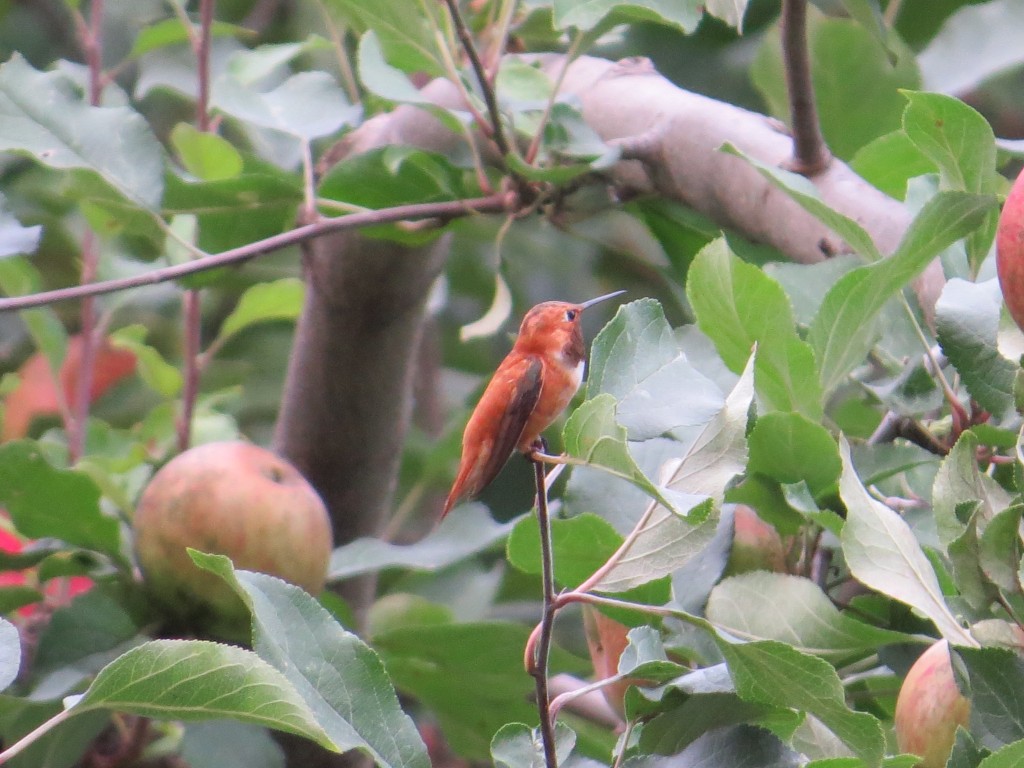
Rufous Hummingbird in Le Sueur, Minnesota
We had to wait nearly 20 minutes for our first glimpse of the bird when it made a brief appearance at the feeder. It was not very active on this day and would disappear for another 15-20 minutes before our next sighting. It was no small thrill to be waiting alongside a couple of Minnesota birding legends, Bob Janssen and Dave Cahlander. I’ve got Bob’s Birds in Minnesota book and am looking forward to his upcoming book on birds of Minnesota State Parks. This was a second author sighting in as many months; I’m going to have to start carting around Evan’s bird book library for autographs.
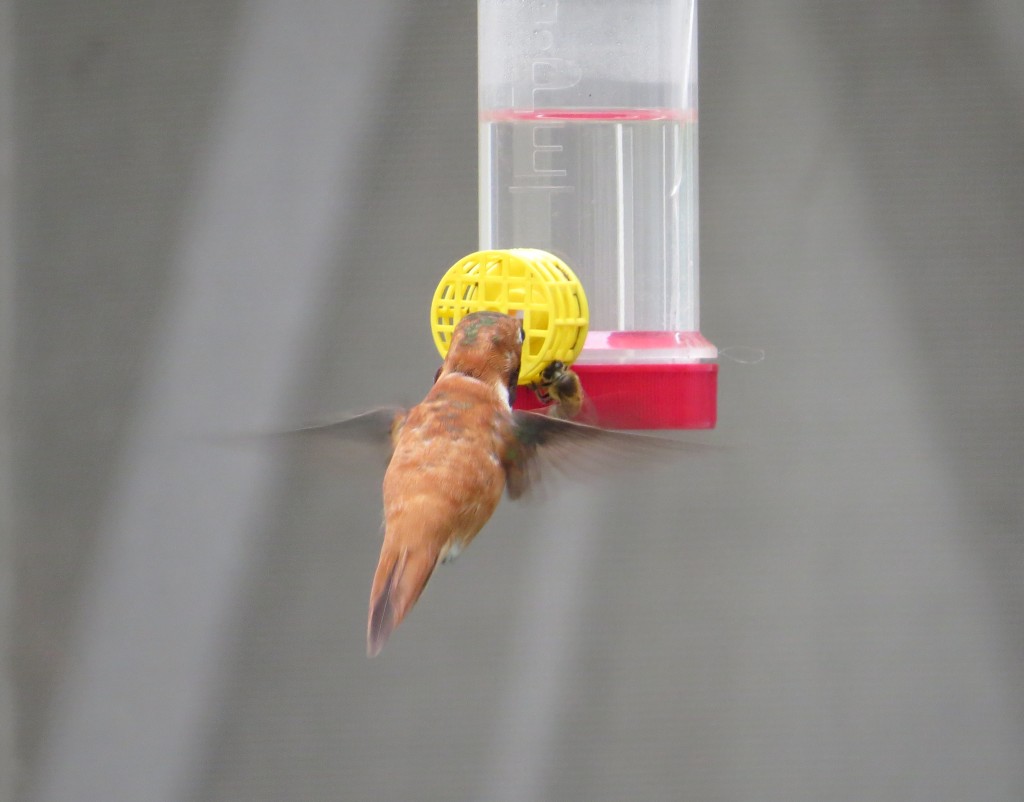
So, Evan got his lifer RUHU, and I got my MN RUHU. Pretty sweet deal all around. Another interesting aside is that Evan is working on some electives in Cub Scouts to earn some patches for his uniform. Several of them involve birdwatching; one in particular was keeping a week-long list of species he had seen. When he started the list, we couldn’t have imagined in our wildest dreams he would be writing down Rufous Hummingbird.
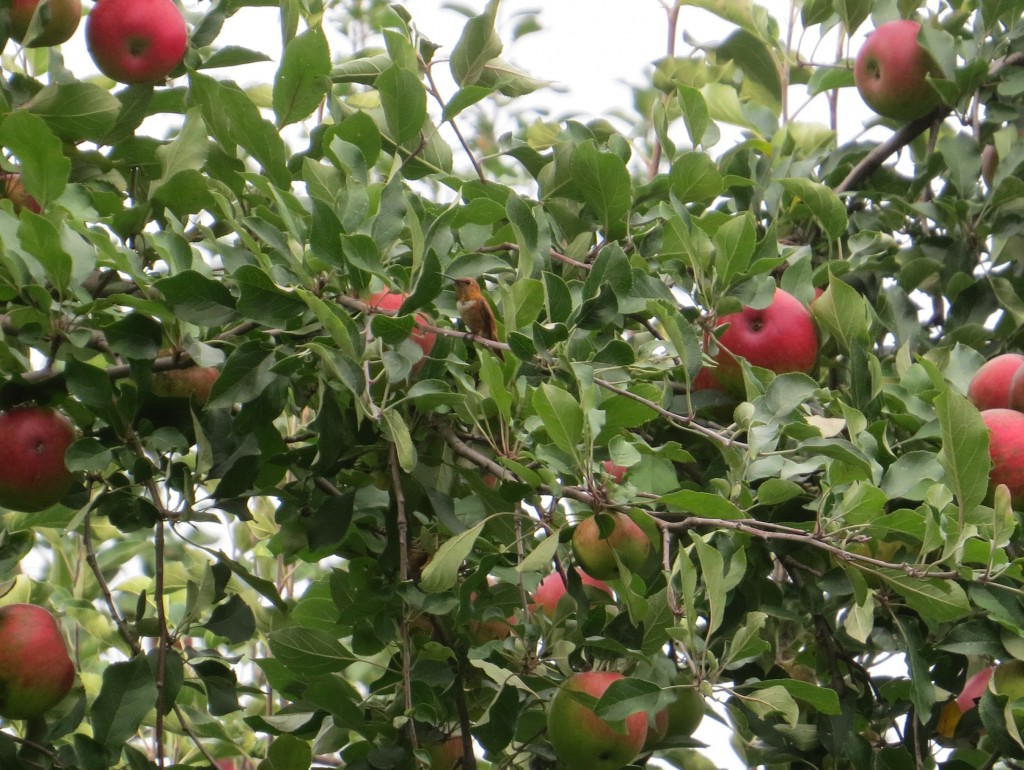
It was nice of the sun and the bird to cooperate for a brief moment to give me a shot of RUHU’s beautiful gorget.
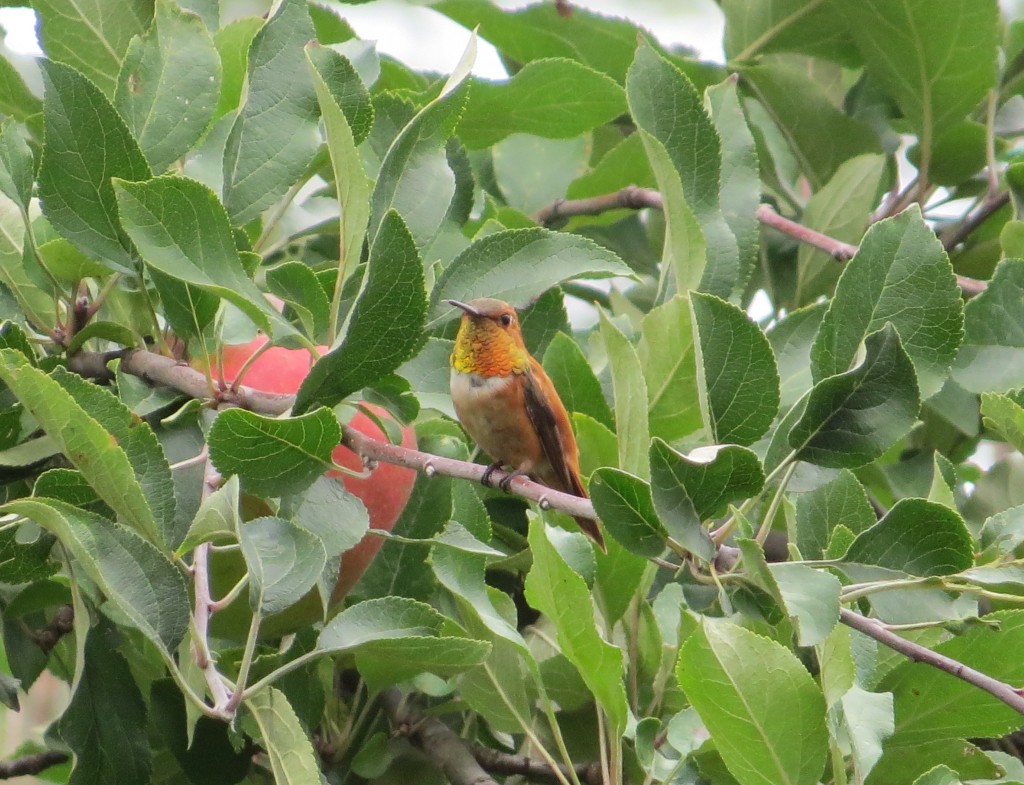
Though we did not get to see the Rufous chase away any Ruby-throats from the feeder he plundered and pillaged, it was clear that no RTHU dared to challenge RUHU, the Red-bearded Pirate-bird. He was a fireball in every sense of the word.
After enjoying a couple more brief sightings, we headed to Mankato so Evan could stop at a Barnes and Noble to pick up his next book in a series he’s reading. It was just our luck to visit on International Talk Like a Pirate Day (September 19th). The kids enjoyed listening to a store employee all decked out in piratewear read a pirate story in a pirate voice. It was topped off with a treasure hunt around the store. No fewer than three adults chortled/gaffawed/giggled when the pirate asked the kids if they wanted to look for her booty.
Since I have many teacher friends who visit this blog, I would be remiss to not mention that Barnes and Noble offers an educator discount. My astute wife had the presence of mind to ask about it. When I learned the discount was a hefty 20%, I hustled on back to the bird section and bought my first Sibley’s. I think I’m a real birder now.
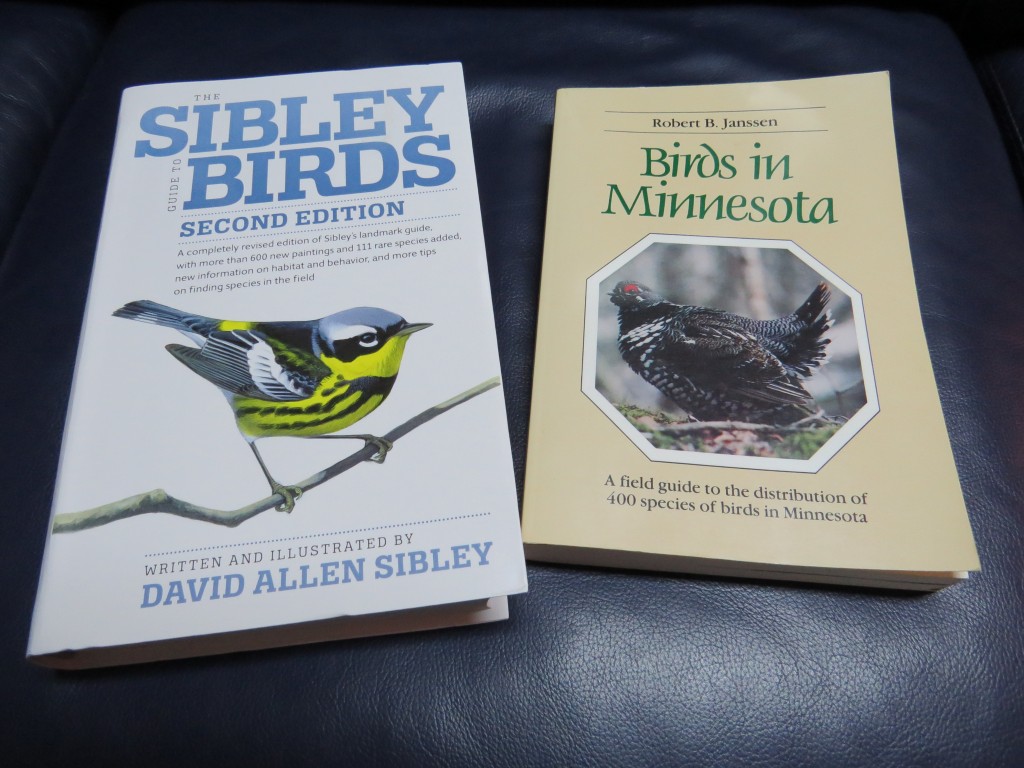
So avast me mates and get ye to the B ‘n N fer some real book treasure to fill the bowels of yer ship! And if ye should see Red-beard, the pirate-bird, raise yer glass of grog to his pirattitude and toss ‘er back in celebration!
3 Minutes
This past Monday morning when I was running errands with Melissa and Marin (we teach on a four-day week), I checked email on my phone while standing in a discount store that does not deserve to be named. Finally, after what seemed like an endless drought of good listserv postings, a stunning vagrant had been found — an adult male Rufous Hummingbird had been coming to the hummingbird feeders of Steve and Mary Nesgoda in Le Sueur. As I read the email, pleasant memories came to mind of bumping into one on a residential street in Maricopa, Arizona last March and then again seeing and photographing one in Westcliffe, Colorado this past July. I smiled as I put my phone away, proud that I had seen this bird already and feeling absolutely no compulsion to chase this one in Le Sueur. After all, I’m not a serious state lister. Sure, I’ll go after life birds, but I haven’t reached the point in my birding where I’ll take a long car trip just to add a bird to my Minnesota column. Abstaining felt good — I felt mature.
Later that day when Evan was home and within earshot, I was musing with my wife about which of the guys would be going after this great state bird as evidenced by this being an ‘Accidental’ species. This was only the fourth male that had ever been seen in the state. I was explaining to Melissa that I’ve seen it before so it made no sense for me to go. Then Evan, with a furrowed brow, piped up and worriedly said, “But Dad, I’ve never seen one.” He spoke a truth that I had completely forgotten; both of my previous encounters had been when I was out birding by myself. This suddenly became an interesting dilemma. With an increasing interest in my state list that has some impressive Accidental and Casual species and with Evan’s lack of RUHU in his life, this bird was now in play.
Still, it took me until Wednesday to pull the trigger on the trip. This bird had been reliably coming to these feeders for several days now. The chase would not be easy to pull off. I didn’t get off work until 4:00. By the time I picked up Evan and let my dogs out, it was almost 5:00 by the time we hit the road. It was just under two hours to Le Sueur. Sunset was at 7:25. It would be tight, real tight. As such, I pressed the pedal of that mini-van down pretty hard. A little too hard. As I met a string of three oncoming cars, I saw the last one was a Kandiyohi County Sheriff’s deputy. Brakes were activated and vigilant eyes were shifted to the rear-view mirror. He turned around. Nuts. Here it comes. I was more aggravated by this encounter slowing me down than I was about a potential ticket. After following me awhile doing a much slower, much more legal speed, he pulled me over. I was not anxious. No, I’ve been waiting for this day for a long time. You see, I’ve had a driver’s license for 19 years now and much to Melissa’s and many others’ frustration, I have never once gotten a speeding ticket. It’s not that I’ve never been speeding. In fact, nothing could be further from the truth. I’m just lucky – really, really lucky. I have been ready to pay my fair share and buy some donuts to boot when the day finally comes. But today was not that day. The gracious deputy just told me to watch my speed. He even had the courtesy to keep the stop brief and get me back on the road within a few minutes.
It was a setback for time, but we pressed on and enjoyed the beautiful day. The temps were in the 70s and the panorama was colorful in every direction. Blue skies were accented with wispy, white clouds, corn and soybean fields were changing from green to gold, and trees and shrubs were changing over into the muted oranges, yellows, reds, and purples of fall on the prairie. It was stunning. The farm/prairie landscape ended rather abruptly when we got to the Minnesota River valley where we were now in a landscape of winding roads, large hills, and woods all around. It, too, was gorgeous. It is in this valley where Le Sueur is found, and despite what the name may suggest, it is a beautiful area. On top of all that, I had made good time getting to our destination not getting lost or having to stop despite not studying maps ahead of time.
We pulled into the driveway of the country home where Steve and Mary live, a quaint place with some farm animals, big shade trees, and an apple orchard. Right away Steve was there to greet me with a handshake and a friendly smile that epitomizes Minnesota Nice. And we were directed to sign their guestbook of birders that had come to see their super-star bird. Evan and I were #s 95 and 96 respectively. Mary took us right over to the feeder where the Rufous Hummingbird had been visiting. I was dubious to follow because we were just a few feet from the feeder. I felt like I should have been behind some glass in a car or a house. She assured us that this bird was unafraid of people, barking dogs, falling apples, etc. It was a real bully of a bird that had been chasing away all the Ruby-throated Hummingbirds. Mary had also told us the bird was just here three minutes before we arrived, and that this was the latest it had ever been seen. She knew we were coming, so she was glad it was still showing. She excitedly told us that everyone on the list had seen her bird. We were optimistic as we waited and watched and waited. We tried to turn many Ruby-throats into our fiery bird, but we just weren’t seeing the celebrity. Mary explained that the Rufous had always gone to bed well before the Ruby-throats and that the now abundance of Ruby-throats was not a good sign since the Rufous always chases them away when he’s around. Our hopes were sinking fast with the setting sun.
In a bit of frustration and boredom I decided I may as well try to finally get a photograph of a Ruby-throated Hummingbird, one of those birding chores I just haven’t gotten around to yet. I didn’t even have that going for me as this guy or gal snubbed my camera at the last second.
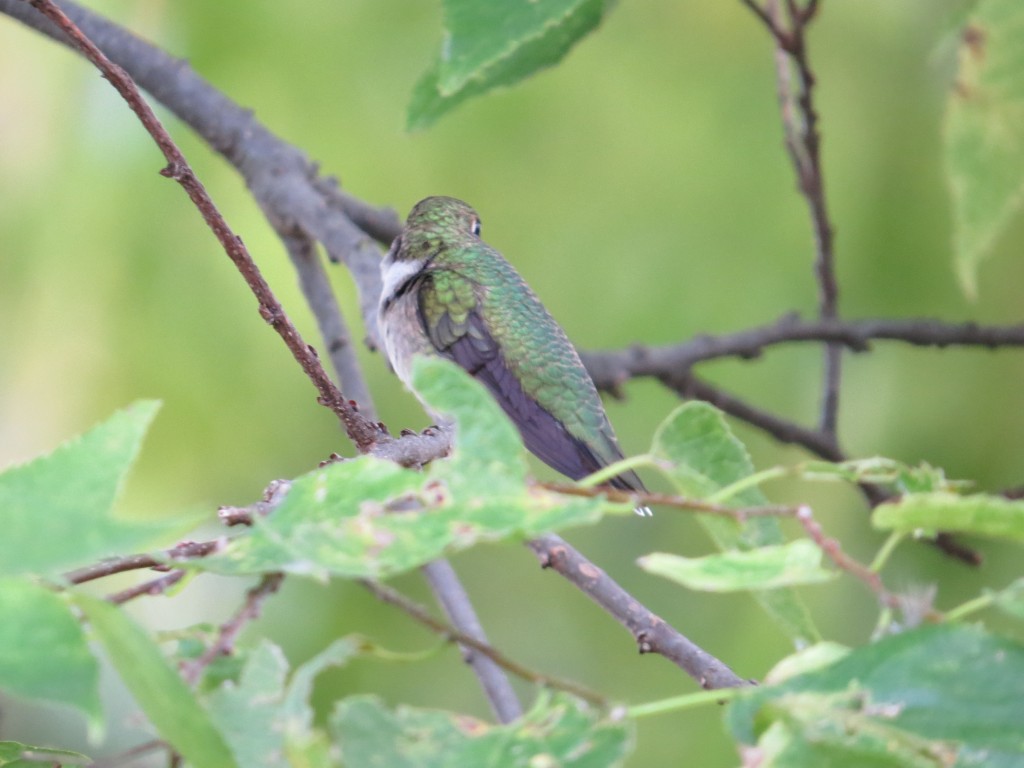
It was now clear that we would not see the Rufous Hummingbird. Three minutes. That traffic stop made the difference between a successful RUHU sighting and an epic fail. Then there is nothing worse than missing the bird than having to make the long trip home. It was only fitting that we should get stuck behind a slow-moving septic tanker, leaving a putrid stench in his wake.
As I drove and tried to breathe, that list kept gnawing at me. Nearly a hundred birders had seen Steve and Mary’s RUHU, except us. Like Jack Shephard in Lost, the urge to go back was as unrelenting as it was impractical. Another weekday chase would likely have the same result, and a full weekend at home made a weekend chase out of the question. Never mind that this bird could just up and leave at anytime. But that list, it haunted me.
TO BE CONTINUED
Google Drive: A New, Easy Way to Embed Photos in an eBird Checklist
It is once again that time of year when the birding has slowed waaaay down. Virtual tumbleweeds are rolling through cyberspace that was once occupied with fast and furious listserv postings and backlogged blog posts. Once again, I find myself trying to fill that virtual void by doing some tech project to help my fellow birders. Last year it was the creation of birdingacrossamerica.com. This year it is something far less ambitious – this post is a simple tutorial on a new way to add bird photos to eBird checklists. Photos add to the richness of the reports we birders submit. They make them just a tad juicier than the others. We can’t resist clicking the lists with that glorious little icon.
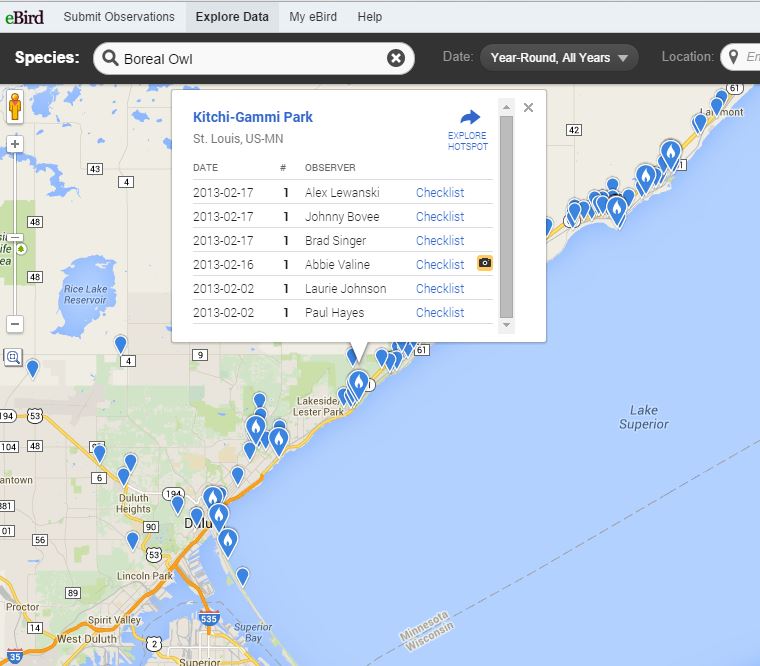
Which eBird checklist would you click on first?
There’s nothing better than opening that icon and BAM! you’re staring at a good, large photo of a great bird like the Northern Hawk Owl.
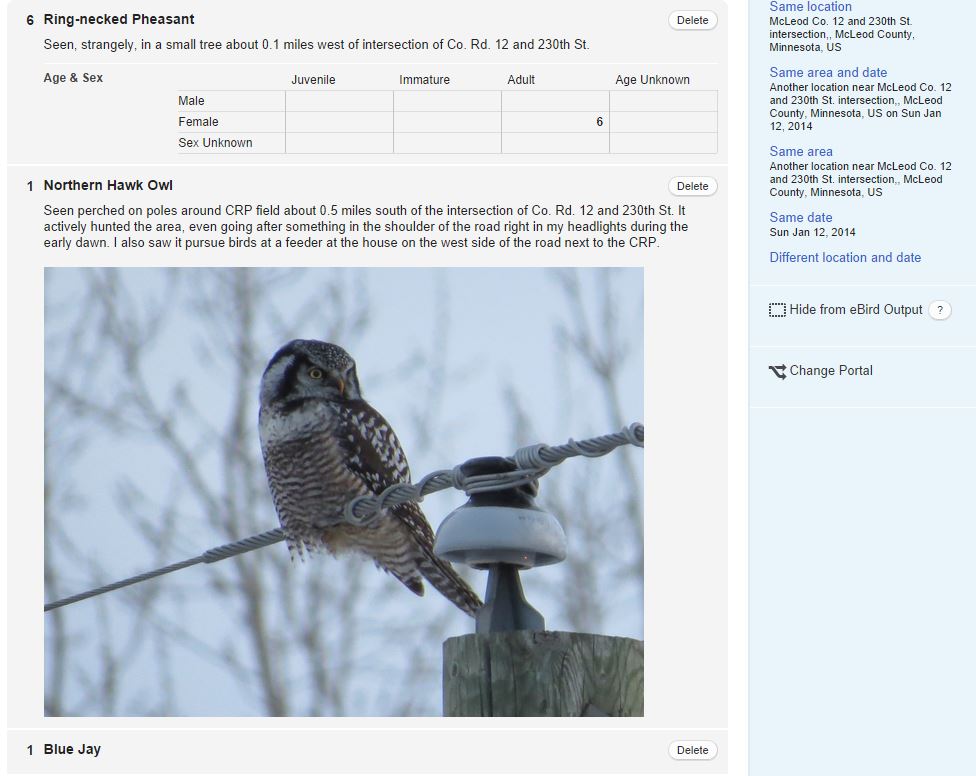
And when you report birds, it’s always nice to provide photo proof of a good bird or birds you saw. Additionally, photos can make it a lot easier for the local eBird moderator to approve your rarity.
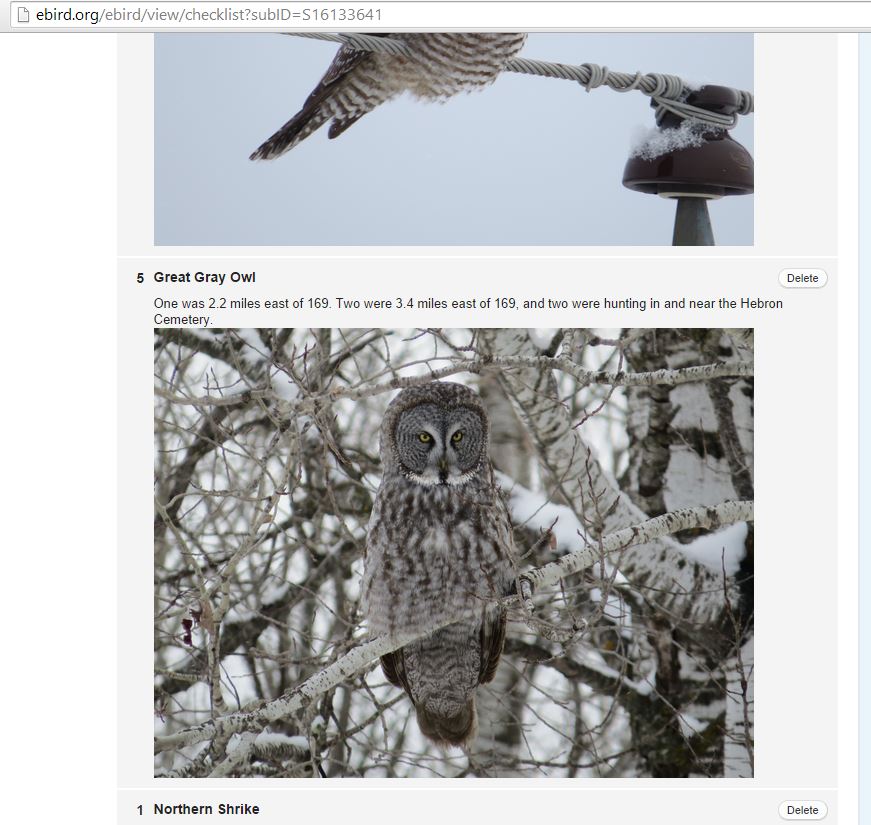
Embedding photos in eBird checklists has never been a user-friendly task, but hopefully this tutorial will take away the mystery and complication of the process for you. Though minimal html coding is still involved (don’t let that freak you out — you can copy off my paper 🙂 ), I’m offering an alternative solution to eBird’s prescribed use of photo-sharing sites like Flickr and Picasa! I had used neither of those before I got into eBird, and personaly I didn’t want another #$%#&! account with another ^%$#@ password where I have a few @ and a couple % sprinkled in that password. Enough is enough, so I found my own path using something I, and probably you, already have – Google Drive. Many of us have been using Drive for some time now to collaborate with colleagues or store files of all types for easy retrieval. Never use it? Well, the probability is high that you have a Google account of some kind already, so therefore you can sign in to Google Drive with your same Google account and password. However, this tutorial is geared toward those with a rudimentary understanding of uploading files to Drive.
Let’s get started.
After you upload your image, you should see a window like the one below. Click ‘Share’.

You should then see this window. Click ‘Get shareable link.’

After you do that, you will see the link has been activated (notice it is green below). You will also see a URL for the image highlighted below.

Copy and paste that URL in a new browser window. Notice how I highlighted the photo’s ID number in the URL. You will need this soon.
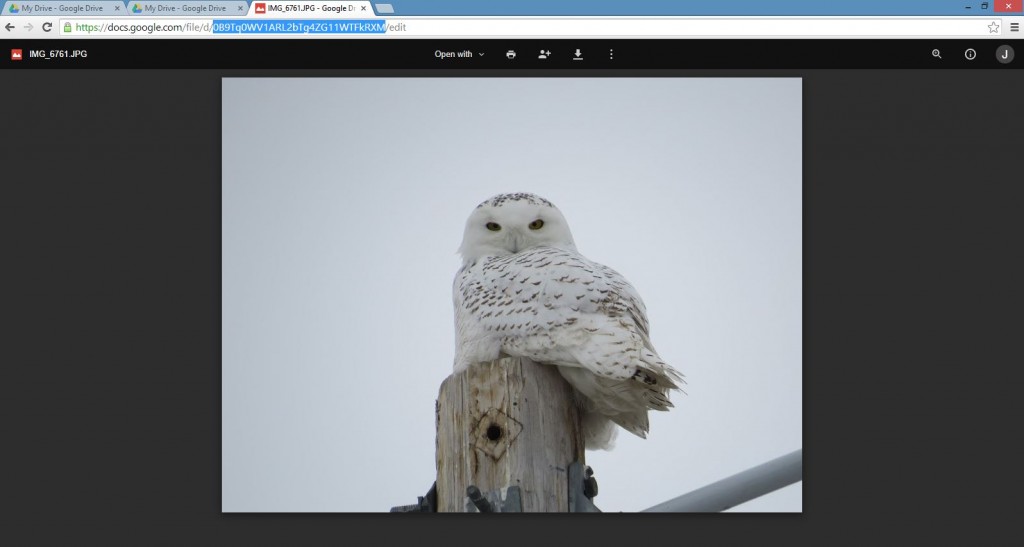
Now open up your already-completed eBird checklist in a new browser window. Click ‘Edit Species List’ and put your cursor in the comments section of the bird for which you want to display a photo.
Next, copy the line of code below and paste it into your comments for that species. Pay attention to the blue text below as you will be replacing it.
<a href=”https://docs.google.com”><img src=”https://docs.google.com/uc?id=0B9Tq0WV1ARL2bTg4ZG11WTFkRXM” /></a>

Now, unless you want this picture of that sweet Snowy in your checklist where a crushing photo of a Ruff should be, you need to do this final step. Locate your photo’s ID number in the URL that I referenced earlier.
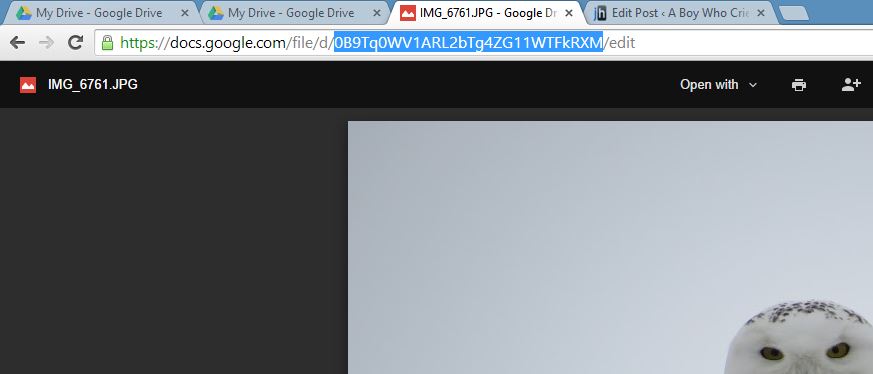
Then paste that ID in the place of the blue text in the line of code you pasted in your eBird checklist. Make sure the old ID number is gone.
That’s it! So go and make eBird a more beautiful place to visit with all your fabulous photos. After all, winter gets long for some of us, and we need some cool bird photos to check out when we’re not prowling for owls.
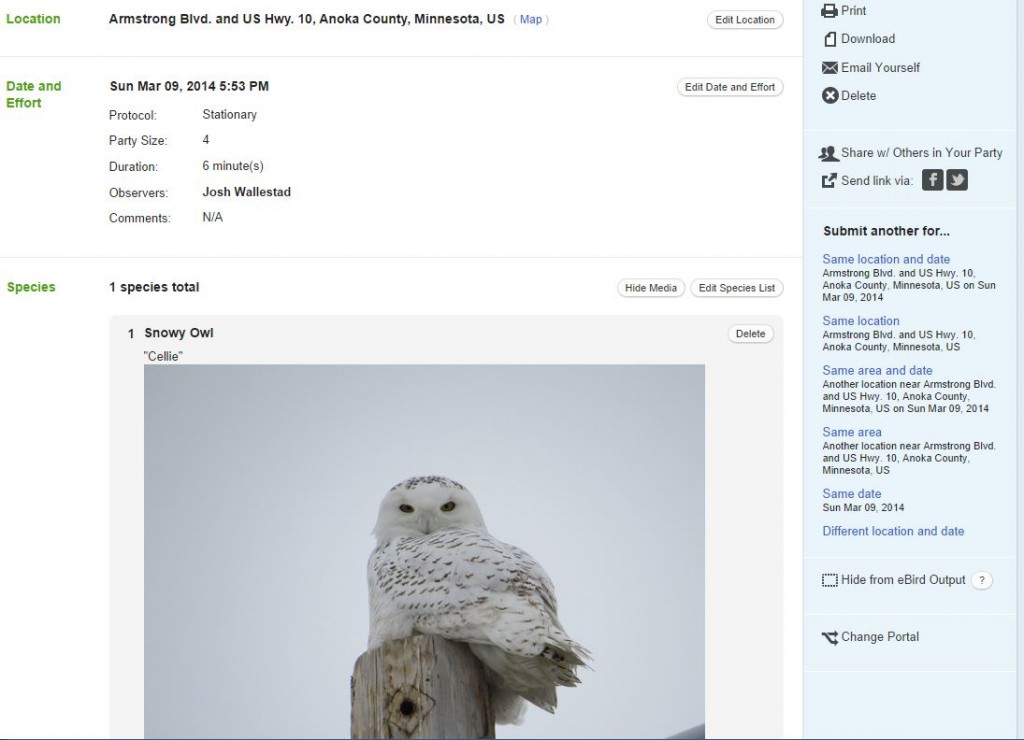
In memory of Jim Halvorson, district technology coordinator and fellow math teacher, who passed away unexpectedly this past week. Jim worked tirelessly and patiently to enhance our craft through technology and its advances. More important than that, he was an all-around great, friendly guy who will be sorely missed.
Least Bittern
Back to Basics – Birding Lake Vermilion
In late August we headed home to northern Minnesota to celebrate my dad’s 70th birthday. It was to be a casual affair with just my family and my brother’s family in attendance; understandably, my sister just couldn’t make it from Nigeria. Nonetheless, it was still a good excuse for us Minnesotans to gather together.
One of the things my mom insisted on doing was taking everybody out for a pontoon ride on Lake Vermilion. She had her own target bird that she wanted to show us all. Apparently my folks had been out on the lake recently and ran into a whole pile of Bald Eagles, dozens of them all in one tree. Secretly I wasn’t too excited about Bald Eagles. The allure has long worn off as I have frequent run-ins with this bird that has now become ubiquitous. We birders can become quite snobbish about our bird species. Nevertheless, the kids would certainly enjoy getting out on a boat. Though I grew up on the water, they do not get this kind of opportunity very often. So a pontooning we would go.
We launched at Peterson landing and set out across Wakemup Bay to the cluster of islands around the larger Taylors Island.
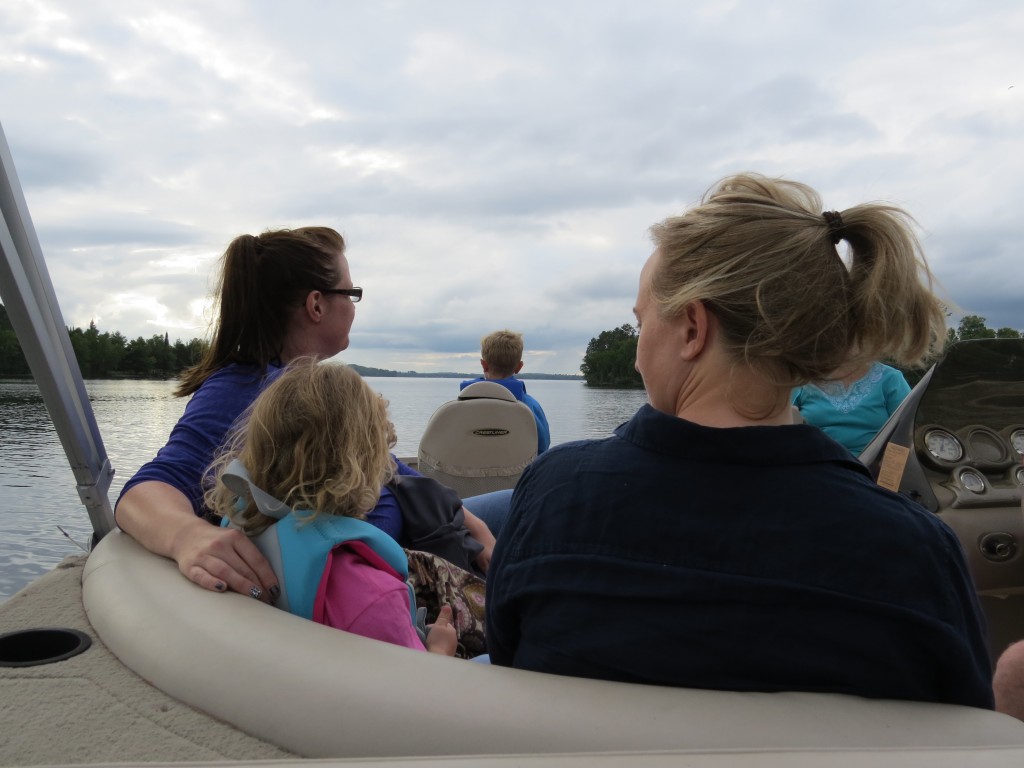
Here, the small channels between the islands provided relief from the wind, and many birds seemed to thrive in the smaller waters. One of the birds fishing in the calm water was none other than our state bird, the Common Loon. I will argue that we have the best state bird in the nation. Its beauty, its haunting call in the middle of a calm night, and its affinity for our scenic lakes make it a fantastic choice for our state’s bird ambassador.
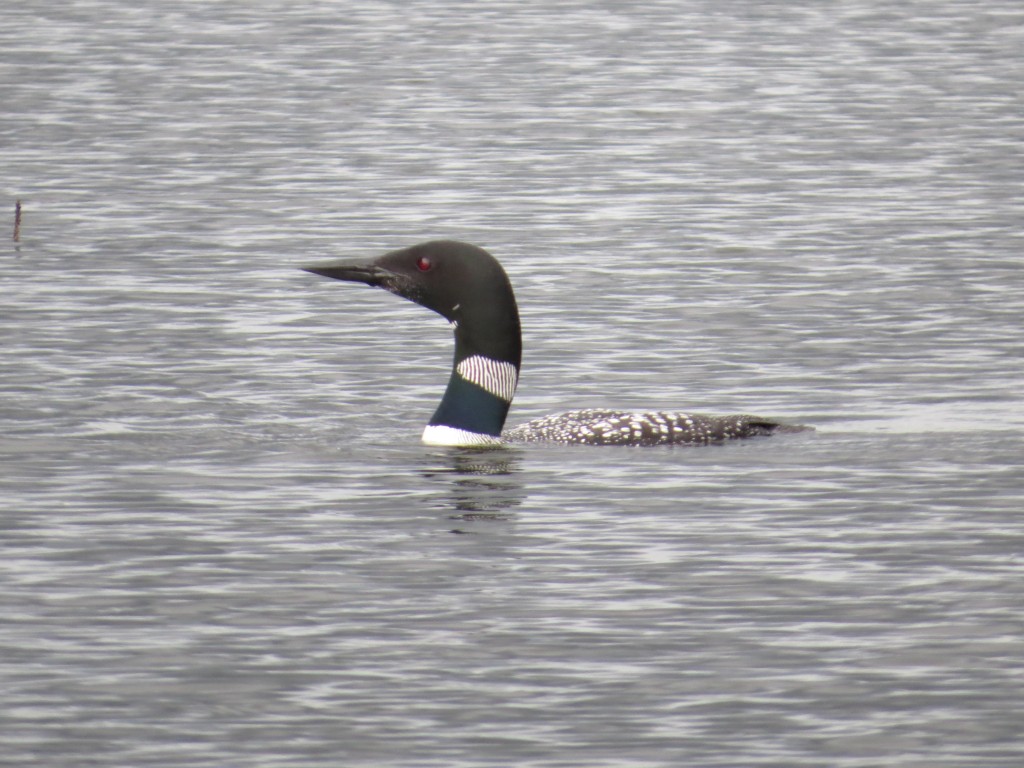
Common Loon, a.k.a. just a “loon” to Minnesotans
We saw several loons, a bird that is even more common on our waters than the Bald Eagle. But it didn’t take long for mom’s target bird to dominate the show. We spotted a nice mature bird in a White Pine.
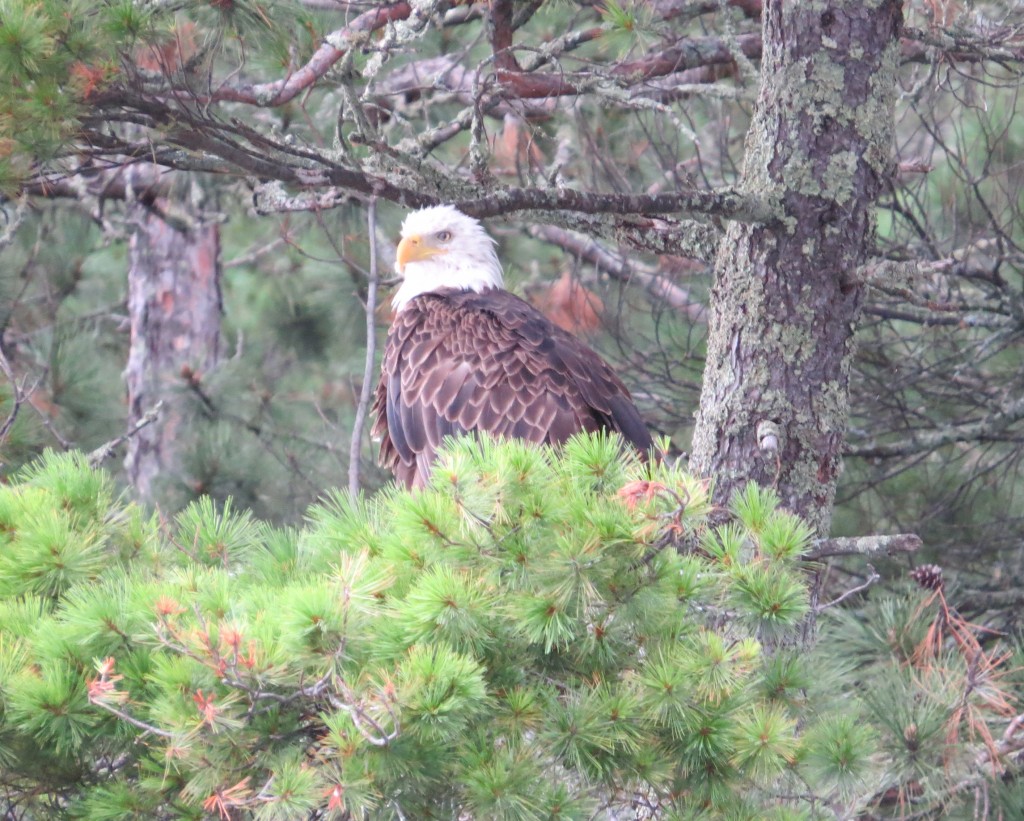
Bald Eagle on Lake Vermilion
And we kept seeing them and seeing them. Some preferred White Pines, some preferred the Red variety.
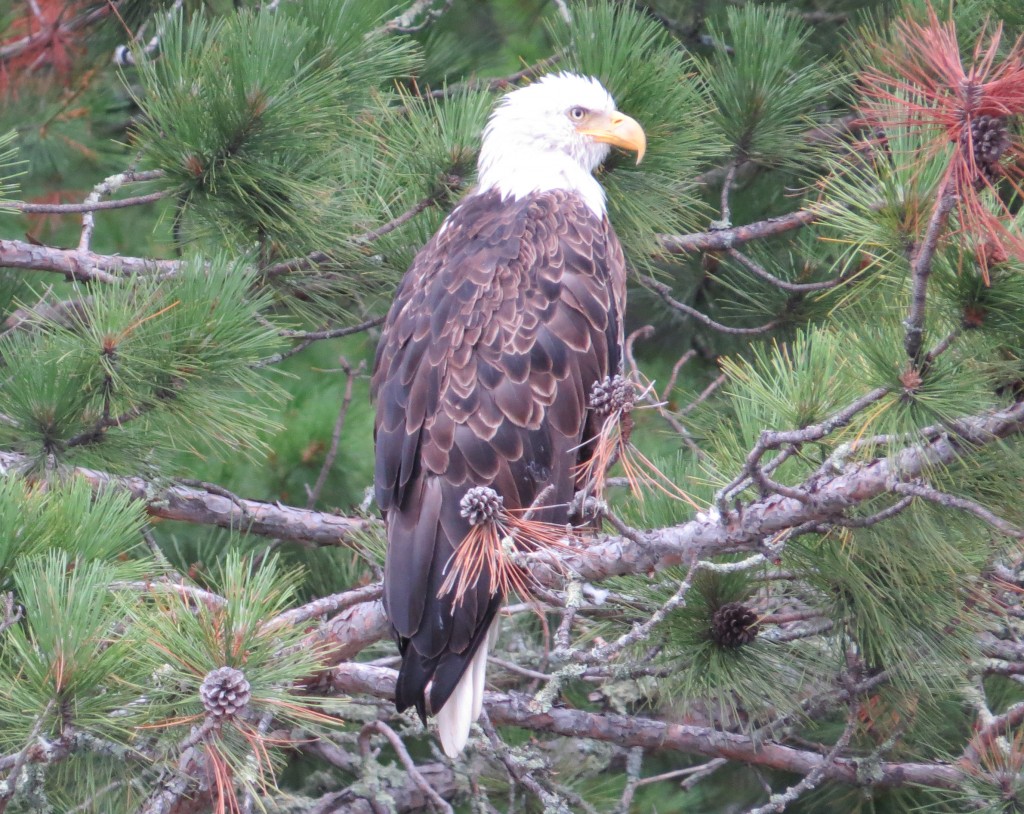
We cruised right along the shorelines of the islands and passed right under many of these birds as they watched from above. Some would take flight; many others did not care. The kids were, by far, the best and most enthusiastic about spotting our national bird.
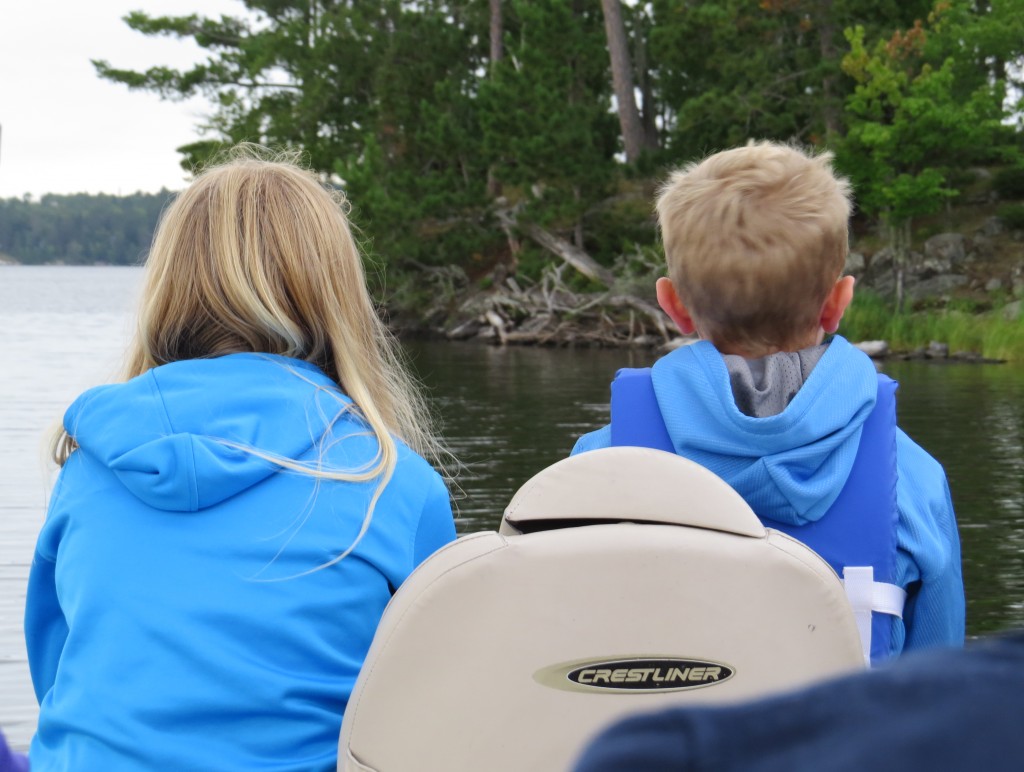
Evan and cousin Iris scanning the trees for Bald Eagles
They were so good at finding them that I hardly had a chance to find my own. They would be pointing and yelling. Just as my eyes would find that one, they’d pick out another one hiding high in the boughs of some pine. Each time I wondered how such massive, obvious birds were evading my eyesight. Even Grandma (mom) was on to them. Now my birder pride was on the line.
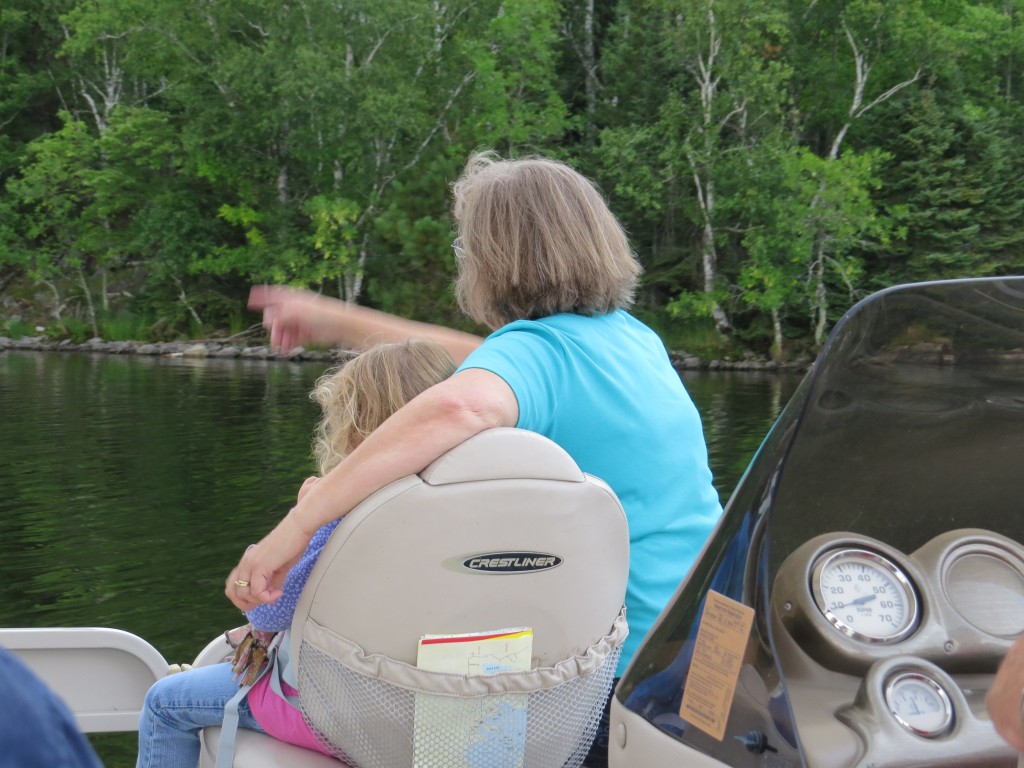
They were absolutely everywhere. In fact, I lost count but I’m guessing we saw close to 20 Bald Eagles, only one of which was an immature. I was able to finally spot one or two myself.
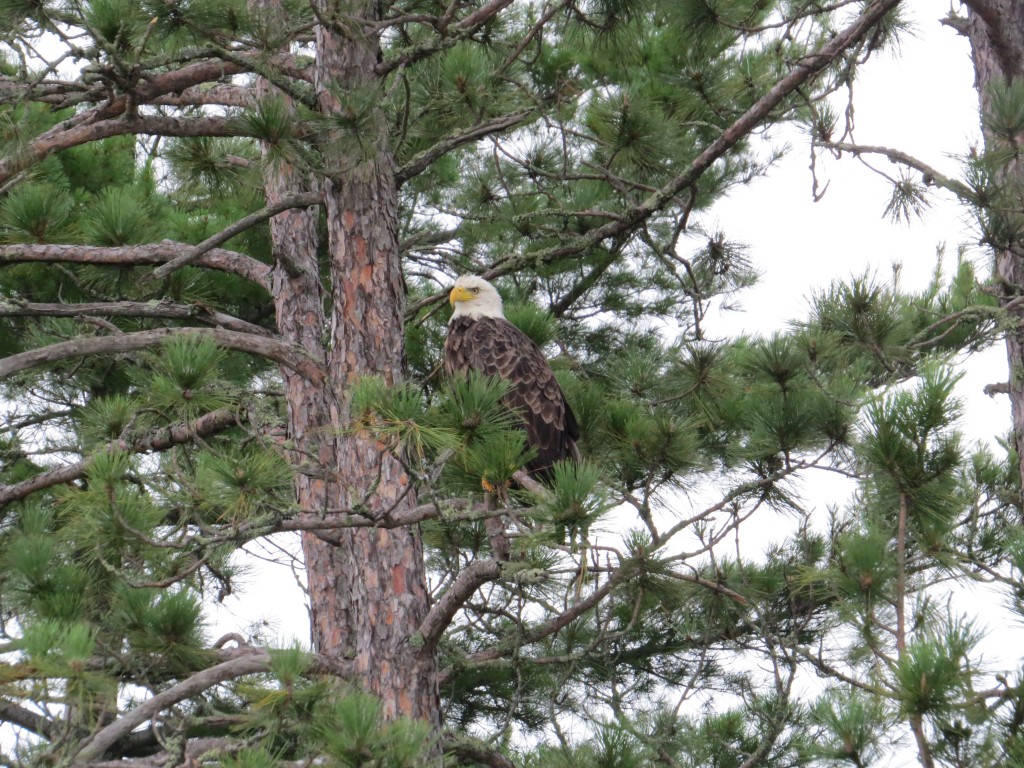
The birds were so plentiful that I never asked Dad to stop the boat so I could take pictures. All of the above were taken while in motion. Had we stopped for pictures, we would have been navigating Lake Vermilion in the dark!
Seeing all these birds was an experience the whole family got caught up in. To add a little more bird flavor to the outing, many exclamations were made over Great Blue Herons hunting from the shorelines and Turkey Vultures gliding effortlessly overhead. Personally I found dozens of migrating Common Nighthawks to be the most exciting. Even the cooler, elder Bro took notice of a low-flying vulture and said, “That’s pretty cool.”
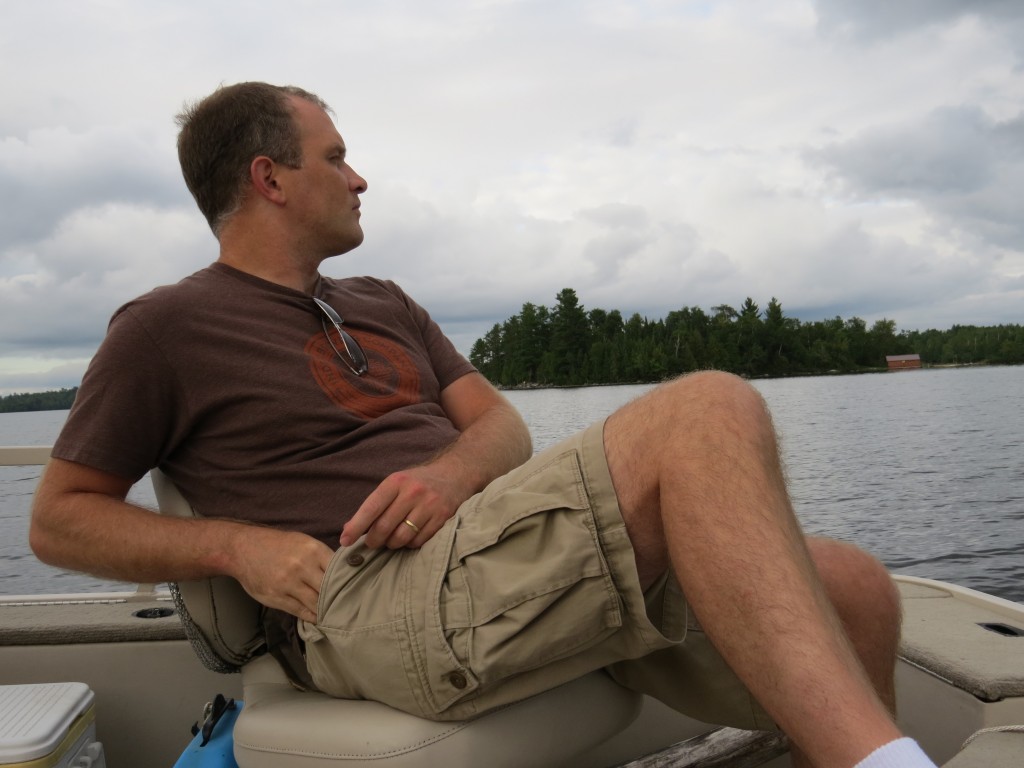
The more eagles we saw, the less jaded I became to them. It truly was an amazing experience to see such an abundance of them. The kids’ enthusiasm was quite appropriate. It was fun to see Evan excited over this bird even though he’s seen it plenty. He doesn’t get fired up over little brown lifers like Winter Wrens, but he still takes childish delight in the birds that are just plain awesome. And rightly so.
Inwardly I was remarking about what a comeback the Bald Eagle has made. According to the U.S. Fish and Wildlife Service, there were only 487 nesting pairs in 1963. Dad, a wildlife biologist during the 1970s, was telling us how the widespread use of DDT got into waterways and poisoned the birds’ food supply, causing them to have weak eggshells and ruining their nesting efforts. Of course the shooting of eagles and lead poisoning also contributed to their drastic decline.
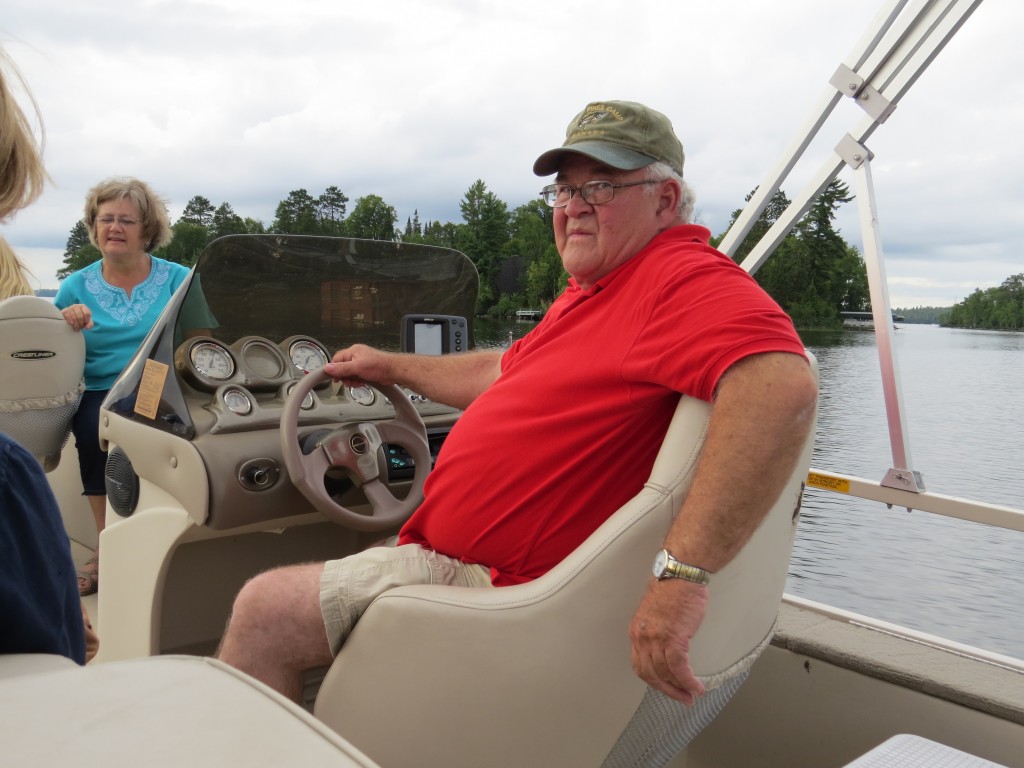
Rick Wallestad – Birthday Boy and former wildlife biologist for the Montana Fish and Game Department
Though the bird had been listed as endangered by 1978 in all but a few of the lower 48 states, it was only ever classified as threatened in Minnesota. Even still, they were regarded with special concern and protection here – Melissa remembers camping at Bear Head Lake State Park with her parents in the mid 1980s and seeing the entire beach area roped off to keep people away from a nesting pair.
The Bald Eagle has made a remarkable comeback reaching nearly 10,000 nesting pairs and thus being removed from the list of threatened and endangered species in 2007. Here we were witnessing the fruit of this wildlife management success story. Ok, Mom, Bald Eagles are cool. Really cool.
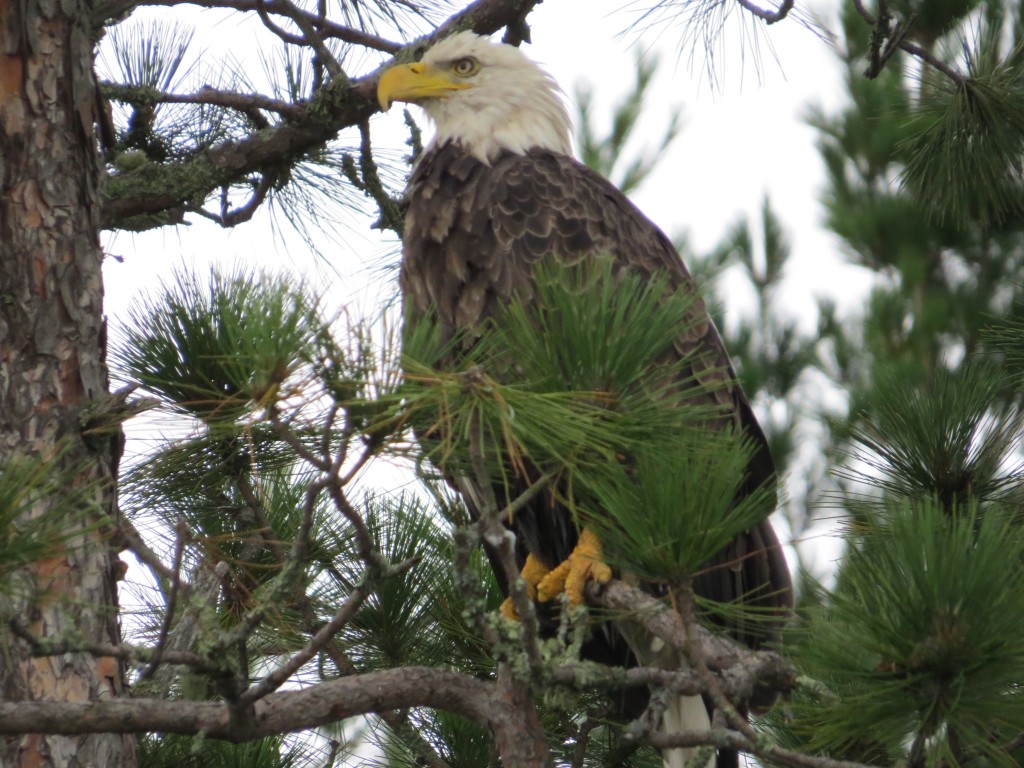
Considering the Bald Eagle’s history, it was fitting that three generations were enjoying this bird together. The past. The future. Certainly lessons learned by previous generations coupled with memorable, childhood experiences of the newest generation will lead to a strong future for the Bald Eagle and the multitude of other bird species that are on the brink of disaster like the Bald Eagle once was. I’ve had the good fortune to see such species, like the Cerulean Warbler or the state endangered Chestnut-collared Longspur. Some day I hope we are swimming in them like we were on this day.
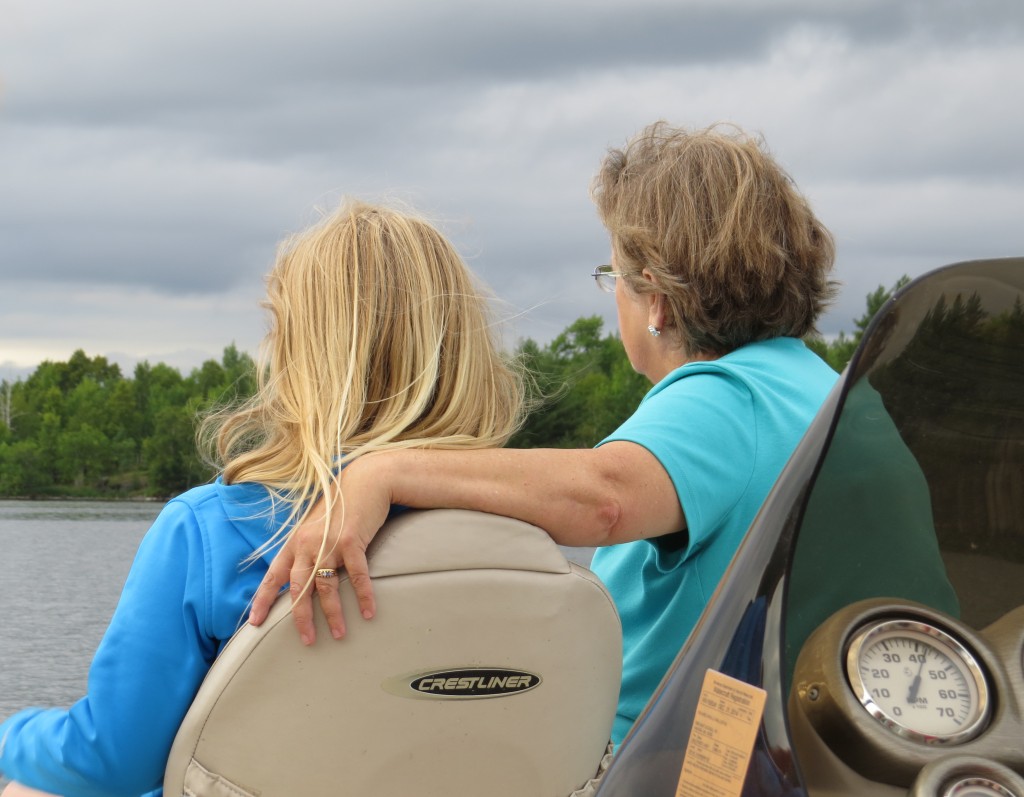
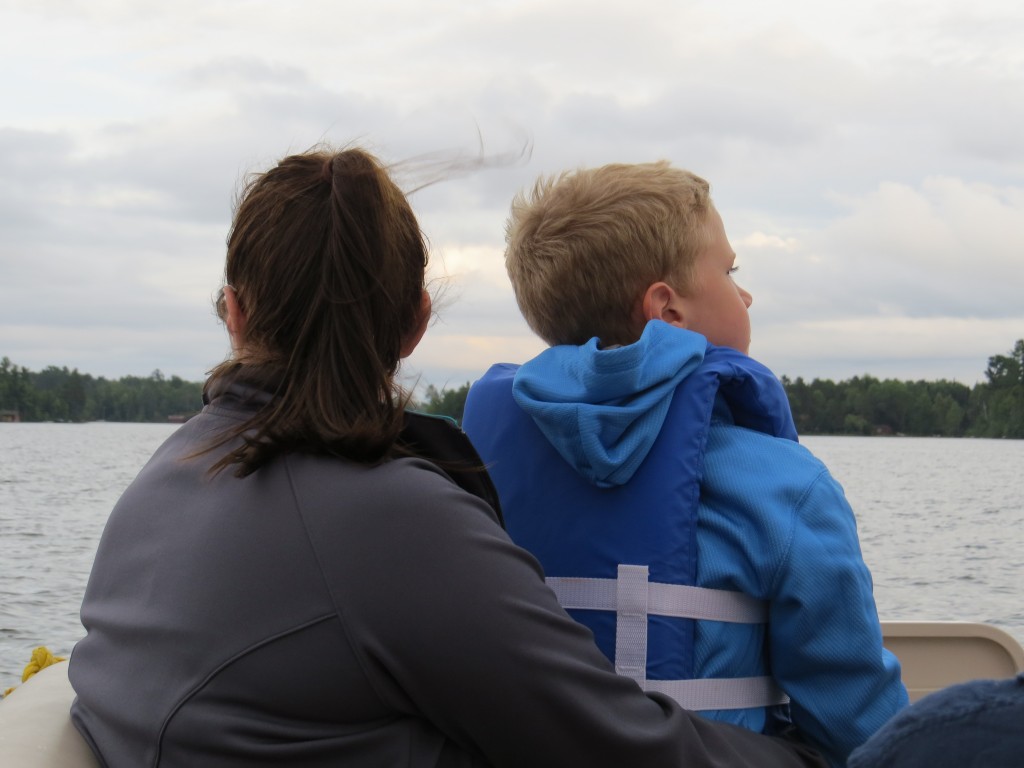
It was time to make our way back across the lake. The kids watched the waves.
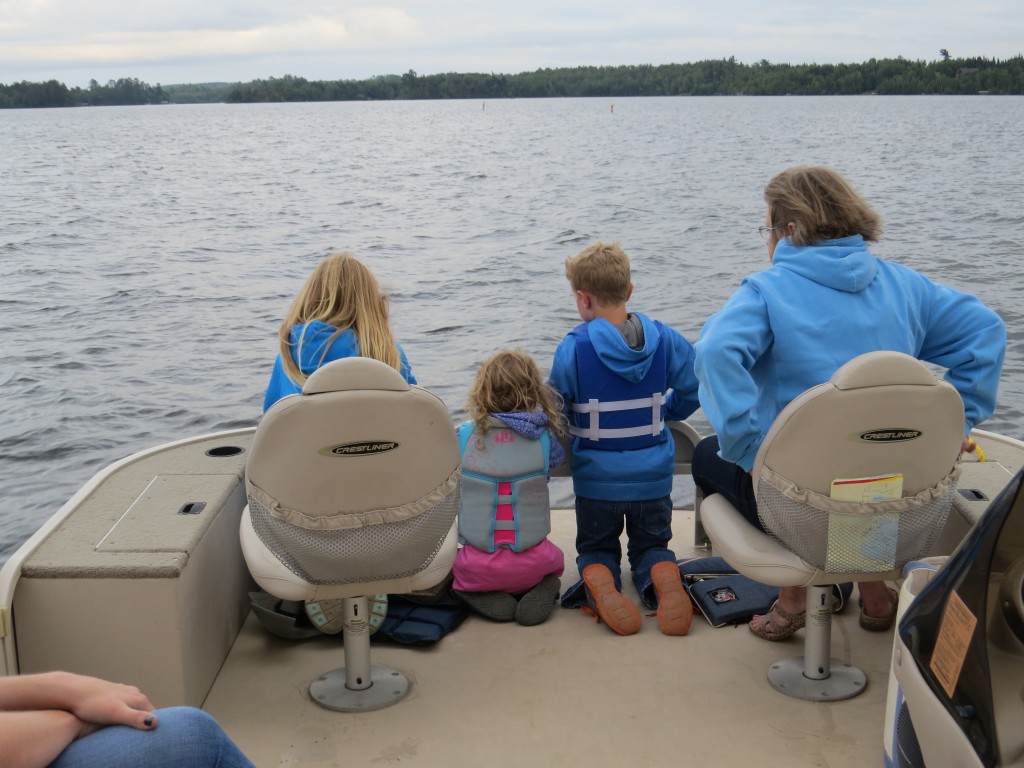
I kept vigil for birds. Finally I found one that made me ask Dad to turn the boat around and stop. I needed a picture of a Herring Gull for my photo collection.
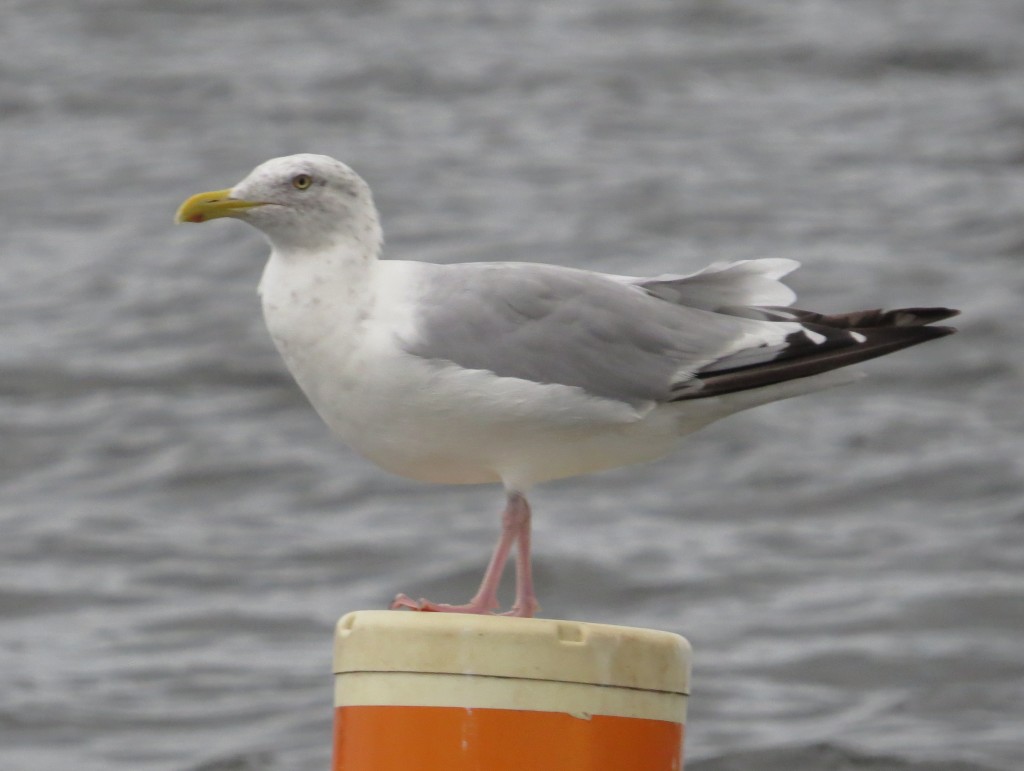
Herring Gull
A couple years ago I couldn’t imagine that my spark for the Bald Eagle would have to be reignited or that I’d be photographing a gull (a type of bird I didn’t care for in my early birding days). Yet here I was doing both. And here Evan, along with the rest, were excited about birds again. The tree of birding had been refreshed with the feathers of eagles, herons, loons, and such. It was good to get back to the basics.
Summer’s Grand Finale
When summer began I had a list of resident birds that had eluded me for over two years. Migrations and periods of summer residency came and went with no sign of these birds that live here at home in Kandiyohi County during the summer months. General laziness and greenhorn status is certainly a part but not the entirety of the cause. No, this list of birds reads like the Who’s Who of the most evasive and elusive birds on the continent. They were dismissed in my early birding days because they are rag-tag bunch of drab and frumpy-looking earth-toned birds. They didn’t bring the ‘wow’ factor like a Scarlet Tanager or a Blue-headed Vireo. Little did I know that this ‘playing hard-to-get’ quality would make them some of the most desirable birds around. So here they are with their current status indicated.
Wood Thrush: Heard Only – the worst way to get a lifer (is that even a lifer?)
Yellow-billed Cuckoo
Black-billed Cuckoo: Conquered – twice over with some crummy photos to boot!
American Bittern – Heard Only/Possibly Seen
Least Bittern
Black-crowned Night Heron Seen – but a pale juvenile far, far away. Sigh.
Henslow’s Sparrow – Heard Only?
Sora – Heard Only successfully converted to Flash Sighting
Virginia Rail – Ditto the Sora
So I guess I was fairly successful since I made contact with all but two on my list. Even still, with nary a decent photo to show for my efforts, my work was anything but satisfactory. There’s no other way to put it – these birds are all just buggers, the whole bunch. Given this C- performance on my wish list and the recent Least Tern fiasco, I’m happy to report that we’d have the last laugh over one of the species on this list and put it to rest photographically speaking. It was a Life Bird thumping with unobstructed views requiring no binoculars. And the icing on the cake was the cool way it all went down. Read on.
With a bathroom project choking out my time and the new school year looming on the horizon, summer birding season pretty much had all but the last nail in the coffin. Part of my back-to-school agenda included a three-day training in downtown St. Paul. On the surface, the Cities may not seem like a birding destination. But I have seen some amazing birds in the Cities because the pockets and puddles of habitat are prowled and scoured by an army of metro birders. And lately they were turning up one very cooperative and photogenic bird from my list. Throngs of people were going to see this bird. My Facebook feed was spammed up with countless photos of this bird in various lights and poses. It was ridiculous how easy people were adding this bird to their life and photo lists. It was cheap. It was unfair. And I wanted a piece of that action.
So what bird could garner such attention? It was none other than the Least Bittern, a couple of them in fact. They were being seen daily from a boardwalk through a marsh at the Wood Lake Nature Center in Richfield. Being in the Cities at the zenith of this Least Bittern mania was a beautiful coincidence. The whole family accompanied me to the Cities. I got trained while hey had fun with their Science Museums, Childrens’ Museums, swimming pools, and such. But the Least Bittern fun would be a family affair.
We got to Wood Lake Nature Center that first night with about an hour of daylight to spare and quickly huffed our way to the boardwalk that cuts right through the middle of the marsh. I wasn’t worried about the time element; I knew there would be other birders there. We just had to look for them and that’s where the bird would be. Sure enough there was guy with a camera as long as my leg and a lady sporting some fancy binos. We were where we needed to be. Of course there were no irrelevant introductions, but rather my first words were to inquire if the bird was present. The answer was no. Before too long the lady went further down the boardwalk to look while the guy stayed put. I have a tough time sitting still when birds are not being seen, so I started in the direction of the lady. That’s when Mr. Camera whistled at us and motioned excitedly with his hand for us to join him. He had it. Evan and I raced down there, and I caught a mere glimpse of bird’s butt disappearing into the reeds. Mr. Camera showed me a lovely photo of the non-butt parts of the Least Bittern that he took just seconds ago. The aggravation!
A short time later the lady came walking back to all of us and told us she had another Least Bittern further down. Mr. Camera was amazingly mobile with his massive apparatus and got down there just as fast as we did. And there we saw a glorious Least Bittern unobstructed just 6 feet off the boardwalk. It was awesome.
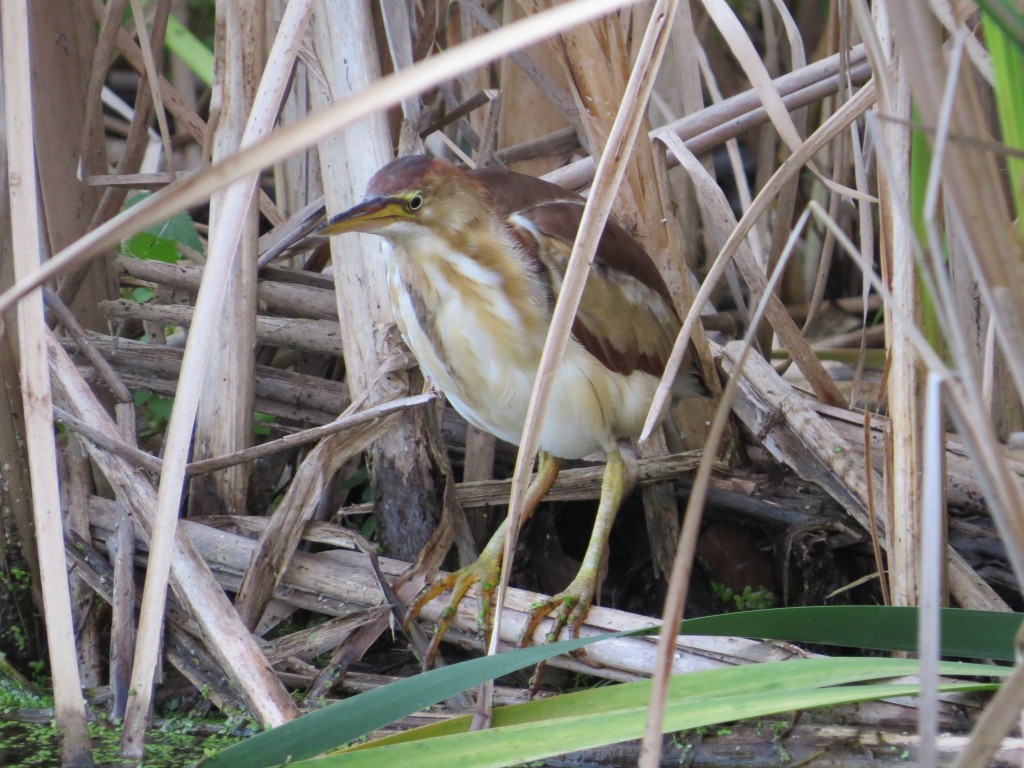
Least Bittern at Wood Lake Nature Center in Richfield
We got to watch this Bittern nab a minnow from time to time. I was never ready with the camera. I usually caught it just before or after such a shot.
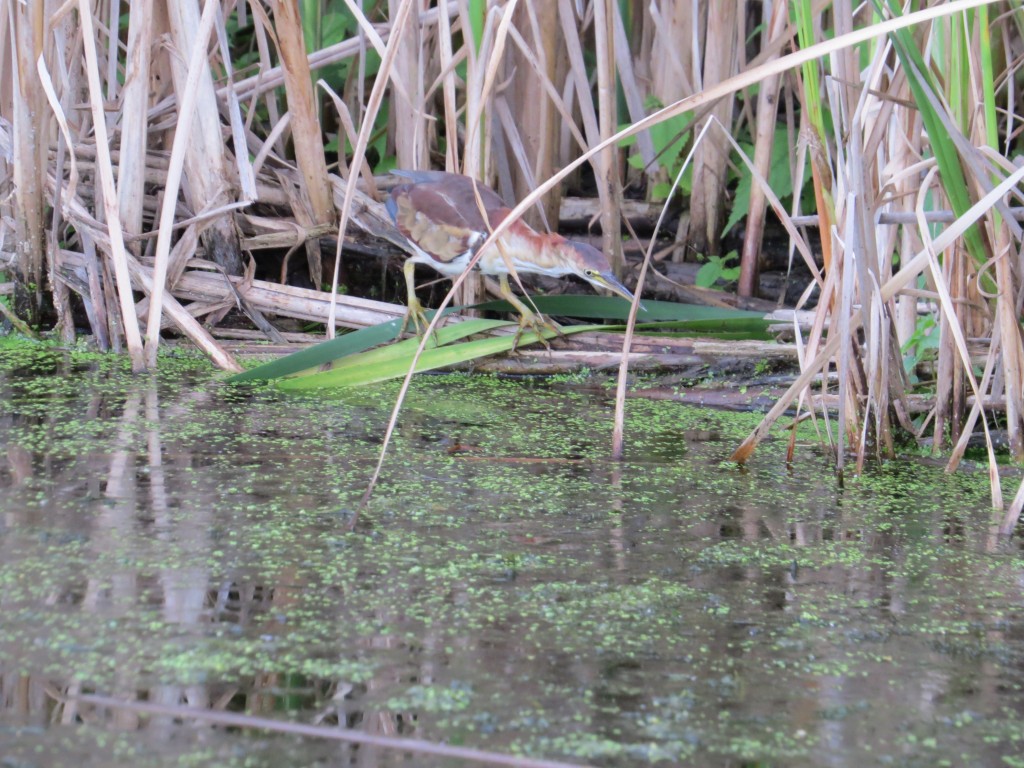
It was incredibly fun to watch. Here Evan is waiting for it to reappear after one of its many disappearances into the reeds.
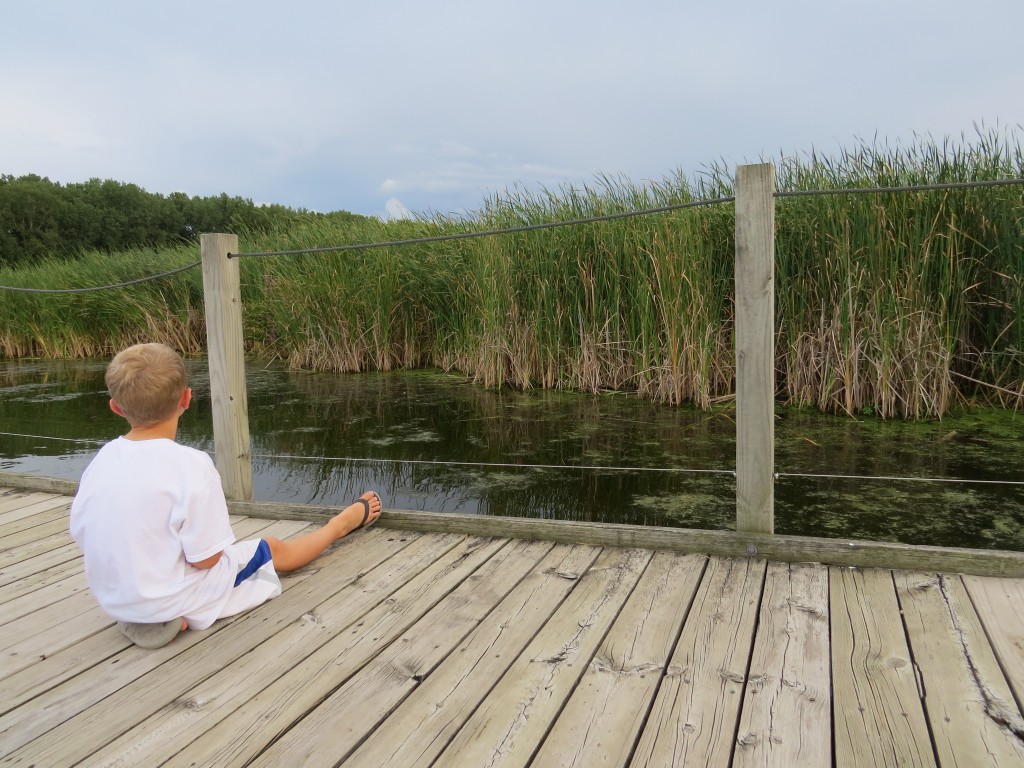 Even Melissa and Marin enjoyed seeing this mysterious, petite bird. But a potential screaming fit caused the two of them to go off on their own birding venture to look at Mallards and such. All of us, from different vantage points, saw this Osprey come sailing over clutching a fat, little meal from someone’s Koi pond.
Even Melissa and Marin enjoyed seeing this mysterious, petite bird. But a potential screaming fit caused the two of them to go off on their own birding venture to look at Mallards and such. All of us, from different vantage points, saw this Osprey come sailing over clutching a fat, little meal from someone’s Koi pond.
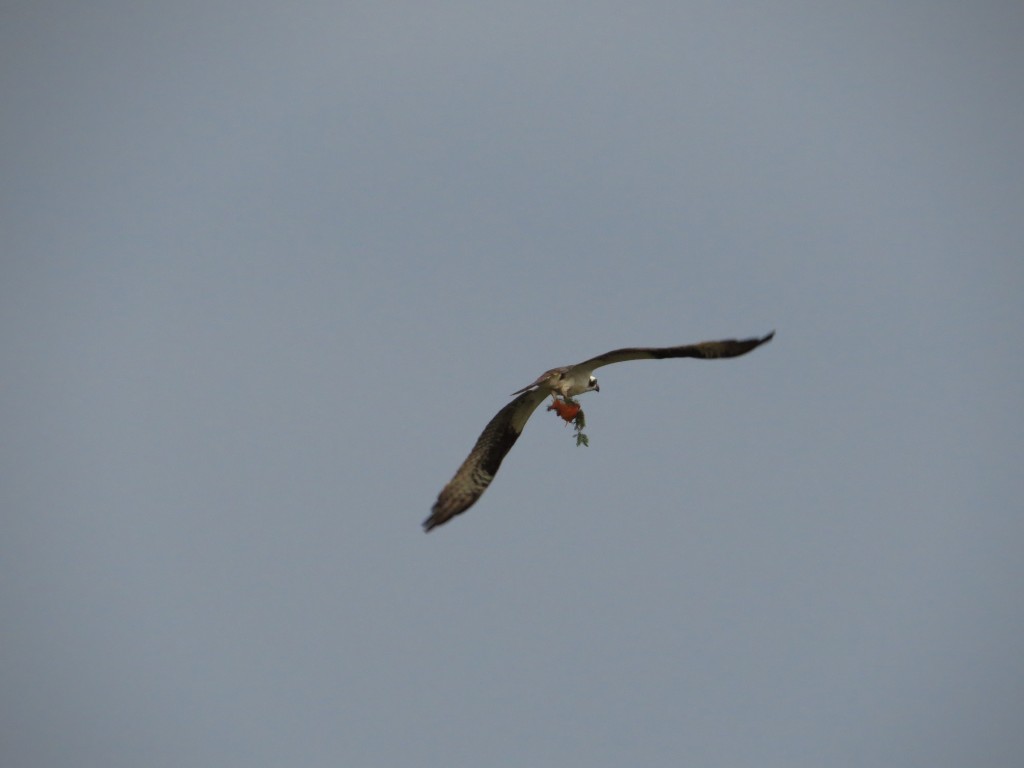
We never had to wait long on the Least Bittern to show up again.
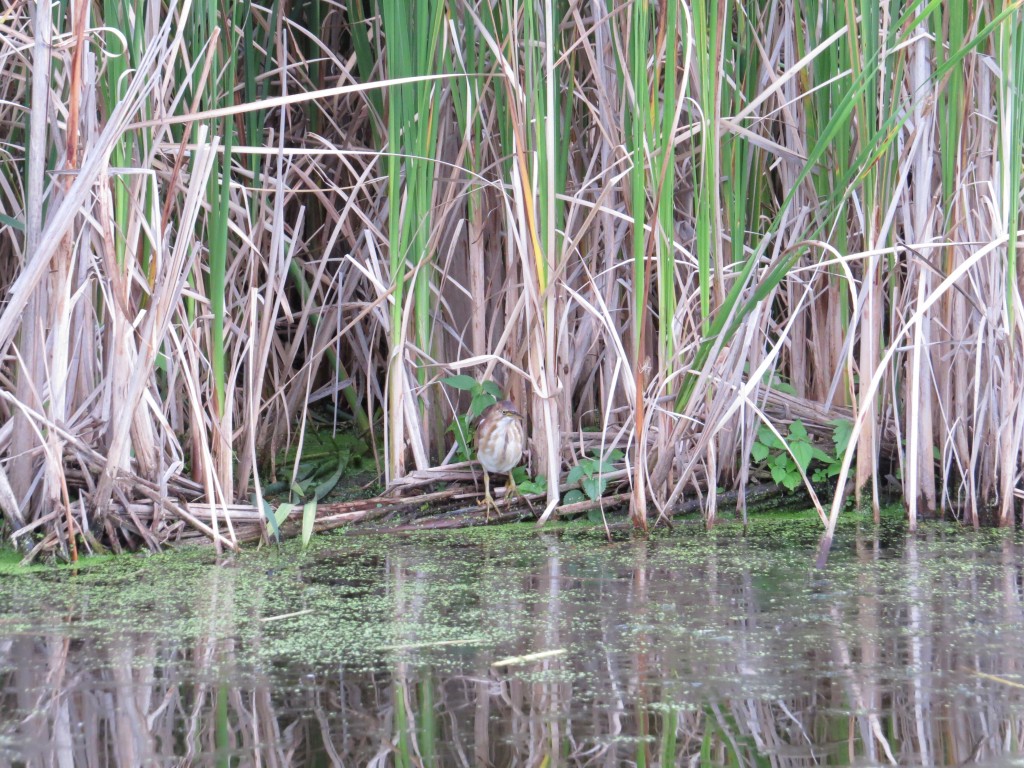
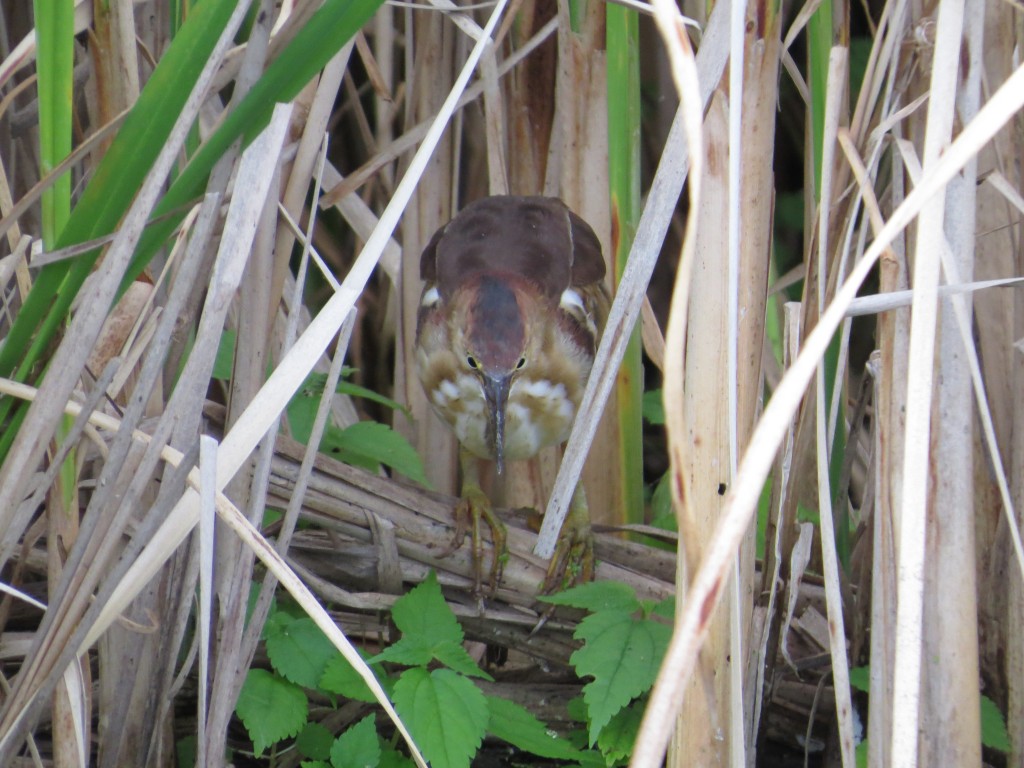
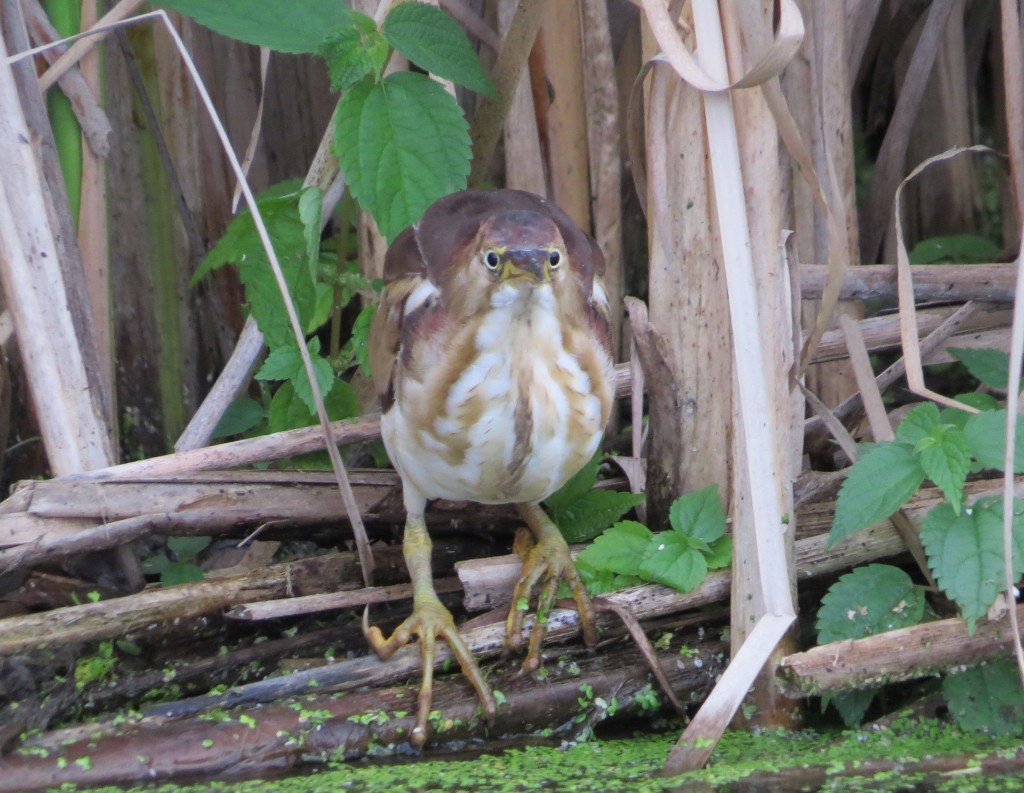 Evan was captivated by this bird. He never watches birds through binoculars, so he often misses just how cool some birds can be. Here he needed none to enjoy the bird. I wanted to capture him in this state, and Mr. Camera and his camera added some birding flavor to the background of the image. Plus he and Evan were visiting about birds as the guy was asking him questions and teaching him things. He was an incredibly friendly guy. Moments after I took this shot, the lady birder pulled me aside and whispered that Mr. Camera was Stan Tekiela, the famed author/photographer of the popular state-by-state birding field guides and other nature guide books!
Evan was captivated by this bird. He never watches birds through binoculars, so he often misses just how cool some birds can be. Here he needed none to enjoy the bird. I wanted to capture him in this state, and Mr. Camera and his camera added some birding flavor to the background of the image. Plus he and Evan were visiting about birds as the guy was asking him questions and teaching him things. He was an incredibly friendly guy. Moments after I took this shot, the lady birder pulled me aside and whispered that Mr. Camera was Stan Tekiela, the famed author/photographer of the popular state-by-state birding field guides and other nature guide books!
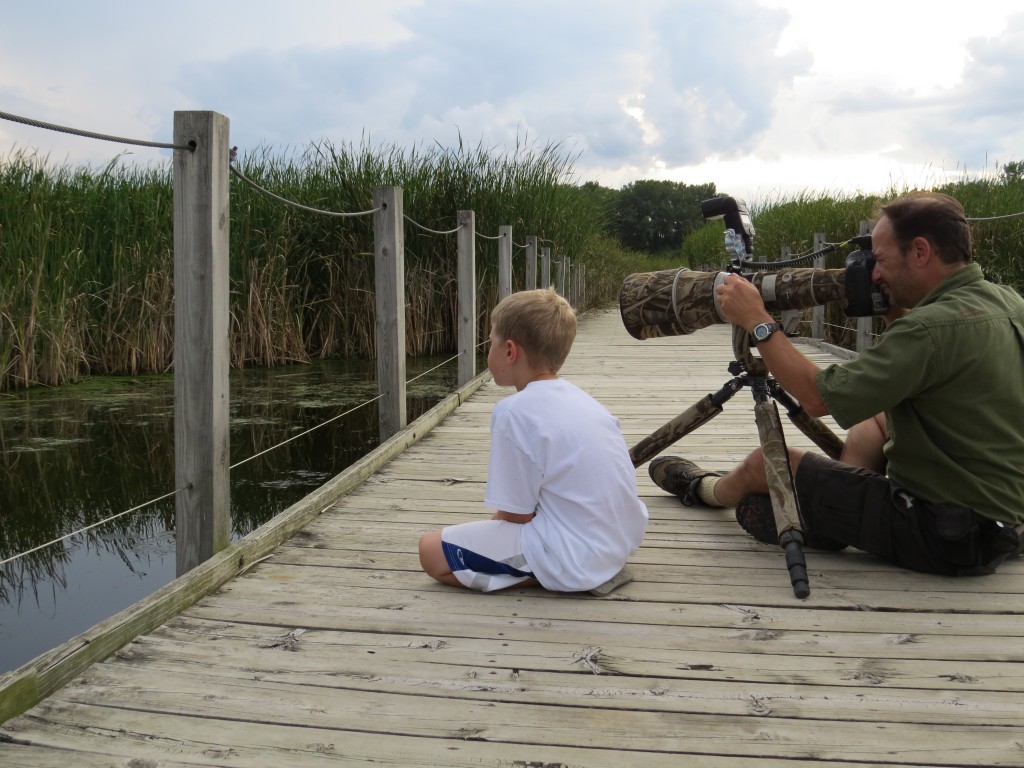
Evan watching a Least Bittern with Stan Tekiela.
I recognized Stan’s name instantly but had trouble recalling where I had seen his name before. Then I remembered a book from Evan’s library of field guides and nature books.
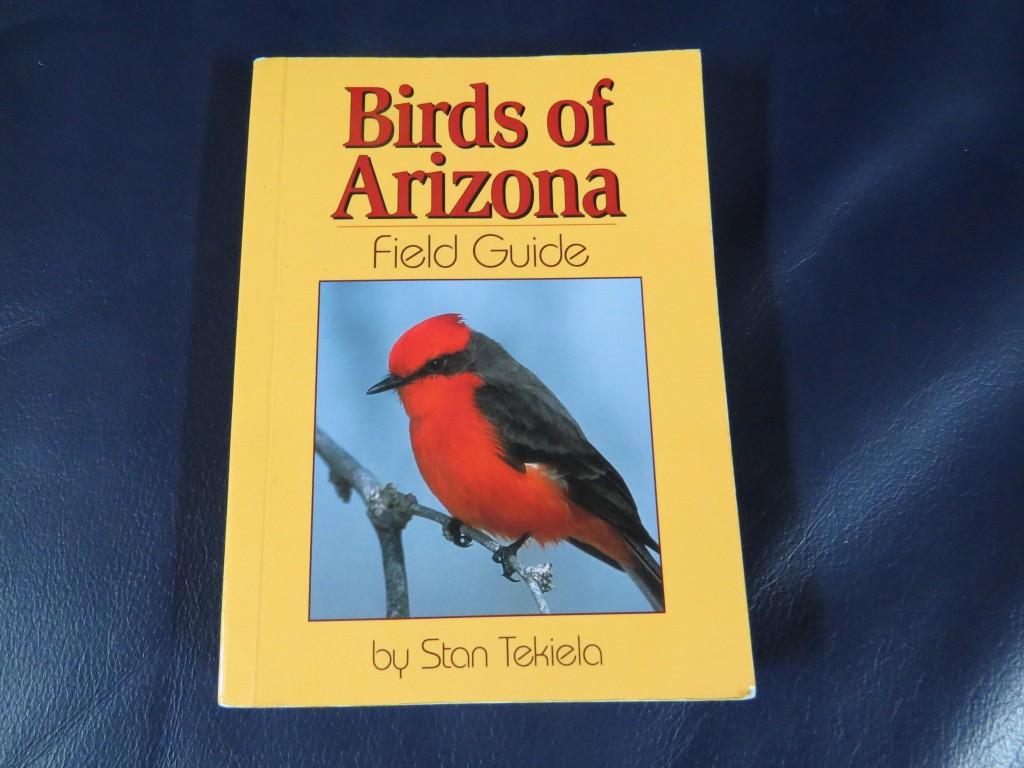
The lady birder implored me to take a picture of my kid alongside Mr. Tekiela. The look in her eye and the tone of her hushed voice indicated this was a big, big deal – so much so that if she had a kid (which she didn’t) she’d definitely get a picture of the two of them together.
It was cool to bump into Mr. Tekiela. But what was really neat was to listen in on the natural conversation between Mr. Tekiela and Evan about all things natural. He truly was an educator who genuinely enjoyed sharing nature with others. Here is a snippet of conversation I overheard:
Mr. Tekiela: “There’s another bird that looks like this that’s a lot bigger.”
Evan: “Yeah, I know.”
Mr. Tekiela: “Do you know what it’s called?”
Evan: “The, uh, uh, American Bittern. We’ve never seen one. We’ve only heard one at my Grandpa’s house.”
Mr. Tekiela: “Do you know what they sound like?”
Evan: “Like…someone throwing rocks in a pond.”
Mr. Tekiela: “That’s right, that’s right! They are called the Slough-Pumper because they sound like an old pump pumping the water out of a slough.”
Mr. Tekiela was quite social and amicable with everyone around. He and I visited for a bit and it came up that Evan had his field guide for Arizona birds. So we visited about Arizona and all his fascinating work in making field guides for that state. He told me for the Arizona mammals book they had to trap all the smaller rodents and photograph them in captivity and then carefully replace each one in the exact same spot they found it in. Another fun story he shared with us was a call he got from law enforcement in the Twin Cities area about an Eastern Coral Snake someone found in the Cities! Mr. Tekiela never was able to relocate the snake, but he showed us a picture of it on his cell phone that the police had sent him.
It was a very fun encounter. But weren’t we looking at a bird? Our visiting never scared it off…maybe it was hanging around listening to Mr. Tekiela’s cool stories…
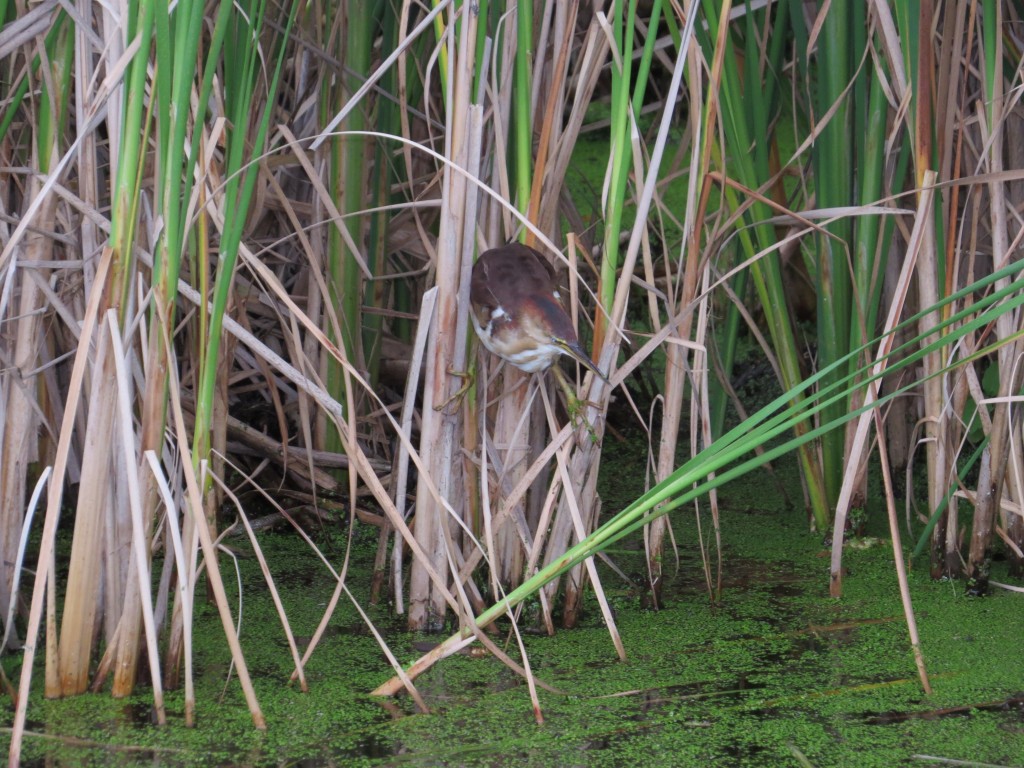
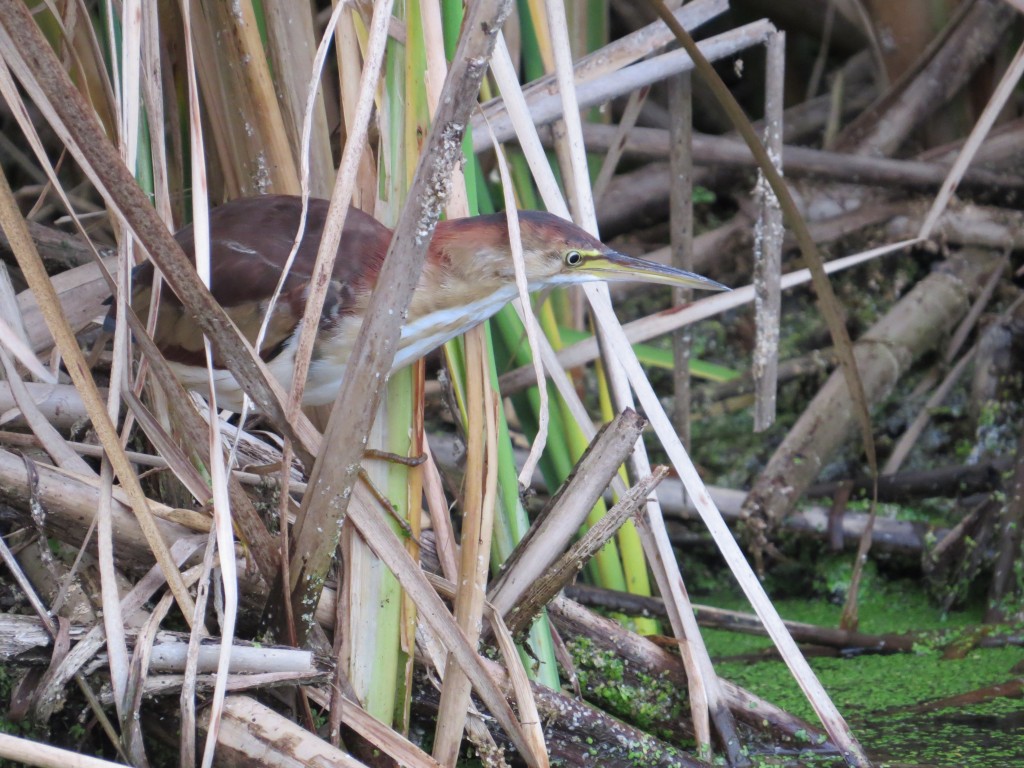
After dozens of Least Bittern photos which was still probably less than 5% of the number Mr. Tekiela had, we decided to keep walking the boardwalk to look for some of the abundant Virginia Rails people had been reporting. Evan had never seen one, and I needed a photo. At one point we were walking back toward where Mr. Tekiela was when he motioned wildly and whisper-yelled, “Evan, come here!” We hustled up there just in time for Mr. Tekiela to point out a Racoon that was creeping out from the reeds and coming to the water’s edge. Evan’s response was “Cool!”
After lingering a bit longer, the rain started to come down. Evan and I took off running to join the girls and get back to the car as Mr. Tekiela chided, “C’mon, you fair-weather birders!” We smiled back and kept running. Once we were under the canopy of the woods and slowed down, I finally told Evan who he was birding and visiting with. His eyes got as big as dinner plates.
It was one heck of a bird to end the summer with and one memorable birder encounter. That’s what I love about this game – you never know what will happen. And most importantly, everybody in the whole family had a genuine good time on this little outing. It was the best way to wrap up the summer birding season. It was perfect.
